Book bought:
-
Books read:
-Informal--Cecil Balmond
-ไม่มีโทรศัพท์และเครื่องปรับอากาศ--วรพจน์ พันธ์ุพงศ์
Saturday, September 30, 2006
Thursday, September 28, 2006
2006-09-28
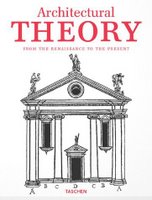
Architectural Theory: From the Renaissance to the Present
Thoenes, Prof. Dr. Christof / Evers, Prof. Dr. Bernd / Berlin, Kunstbibliothek
ISBN 3-8228-1699-X
Of buildings and men
If you’ve ever wondered what goes through architects’ minds when they design buildings, you’ll be happy to know that there’s no shortage of brilliant reading material to satisfy your curiosity. Wading through the archives at your local library may prove fruitful to your endeavor, but it won’t give you the instant gratification that Architecture Theory will. This book brings together all of the most important and influential essays about architecture written since the Renaissance, copiously illustrated and neatly organized chronologically by country. From Alberti and Palladio to Le Corbusier and Koolhaas, the best treatises by architecture’s greatest masters are gathered here, each accompanied by an essay discussing its historical context and significance. This is the all-in-one, must-have book for anyone interested in what architects have to say about their craft.
The comprehensive overview that will help transform even the most uninformed novices into well-informed connoisseurs!
The authors: Christof Thoenes studied art history in Berlin and Pavia, before completing his doctorate in Berlin. Thoenes lives in Rome, where for many years he has worked for the Bibliotheca Hertziana (Max-Planck-Institute), and is honorary professor in Hamburg. He has contributed to numerous publications on Italian art, particularly on architecture and architectural theory of the 15th to 18th centuries. Bernd Evers completed his doctorate in art history before embarking on a career as a librarian; since 1985 he has been director of the Kunstbibliothek der Staatlichen Museen in Berlin. He has published numerous articles on book and library studies, and a central topic of his research is the architectural history of the 17th to 19th centuries.
+:+:+:+:+:+:+:+:+:+:+:+:+:+:+:+:+:+:+:+:+:+:+:+:+:+:+:+:++:+:+:+:+:+:+
Book bought:
-Architectural Theory: From the Renaissance to the Present--Thoenes, Prof. Dr. Christof / Evers, Prof. Dr. Bernd / Berlin, Kunstbibliothek
Books read:
-Informal--Cecil Balmond
-ไม่มีโทรศัพท์และเครื่องปรับอากาศ--วรพจน์ พันธุ์พงศ์
Wednesday, September 27, 2006
2006-09-27
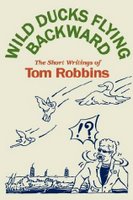
Wild Ducks Flying Backward
Tom Robbins
ISBN: 0553902946
Known for his meaty seriocomic novels–expansive works that are simultaneously lowbrow and highbrow–Tom Robbins has also published over the years a number of short pieces, predominantly nonfiction. His travel articles, essays, and tributes to actors, musicians, sex kittens, and thinkers have appeared in publications ranging from Esquire to Harper’s, from Playboy to the New York Times, High Times, and Life. A generous sampling, collected here for the first time and including works as diverse as scholarly art criticism and some decidedly untypical country-music lyrics, Wild Ducks Flying Backward offers a rare sweeping overview of the eclectic sensibility of an American original.
Whether he is rocking with the Doors, depoliticizing Picasso’s Guernica, lamenting the angst-ridden state of contemporary literature, or drooling over tomato sandwiches and a species of womanhood he calls “the genius waitress,” Robbins’s briefer writings often exhibit the same five traits that perhaps best characterize his novels: an imaginative wit, a cheerfully brash disregard for convention, a sweetly nasty eroticism, a mystical but keenly observant eye, and an irrepressible love of language.
Embedded in this primarily journalistic compilation are a couple of short stories, a sheaf of largely unpublished poems, and an off-beat assessment of our divided nation. And wherever we open Wild Ducks Flying Backward, we’re apt to encounter examples of the intently serious playfulness that percolates from the mind of a self-described “romantic Zen hedonist” and “stray dog in the banquet halls of culture.”
--------------------------------------------------------------------
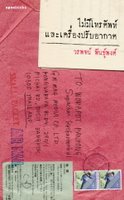
ไม่มีโทรศัพท์และเครื่องปรับอากาศ
วรพจน์ พันธุ์พงศ์
ISBN: 974-94665-3-5
ความเรียงคัดสรรจากคอลัมน์ being there ในนิตยสาร IMAGE และ 'เต้นรอบกองไฟ' ในนิตยสาร GM ที่ตีพิมพ์ในปี 2547-2549 ช่วงที่มีการเปลี่ยนแปลงเกิดขึ้นกับชีวิตผู้เขียนหลายด้าน ทั้งการงาน สัมพันธภาพ โดยเฉพาะทัศนคติที่นับวันยิ่งหักเหออกจากกระแสหลักมากขึ้นทุกที
ไม่ใช่ไม่เชื่อในระบอบประชาธิปไตย เทคโนโลยี หรือทุนนิยม แต่ถ้ามันไม่เหมาะ ไม่พอดี ไม่มีความสุข เราจำเป็นต้องแสวงหาหนทางใหม่—อาจเป็นการเดินย้อนกลับไปหาภูมิปัญญาบรรพบุรุษ หรือผสมผสาน หรืออะไรสักอย่าง ด้วยหวังว่าจะเป็นความลงตัวครั้งใหม่ หลังการ 'เปลี่ยนผ่าน' ซึ่งหมายความเช่นเดียวกับการเปลี่ยนแปลงทุกครั้งของทุกคน ที่เลี่ยงไม่พ้นภาวะทุกข์ทรมาน นอนมองเพดานอยู่หลายคืน
แต่ก็นั่นแหละ มนุษย์เป็นเพียงสิ่งมีชีวิตเล็กๆ มีอายุแสนสั้น ในวันหนึ่ง ทุกสิ่งทุกอย่างก็จะผ่านพ้นไป
สิ่งสำคัญคือระหว่างนั้น เราจะเอายังไงกับชีวิต กัดฟันสู้ หรือปิดหูปิดตา
+:+:+:+:+:+:+:+:+:+:+:+:+:+:+:+:+:+:+:+:+:+:+:+:+:+:+:+:++:+:+:+:+:+:+
Books bought:
-Houses of Asia--Editorial director: Kelley Cheng
-Wild Ducks Flying Backward--Tom Robbins
-ไม่มีโทรศัพท์และเครื่องปรับอากาศ--วรพจน์ พันธุ์พงศ์
Books read:
-Informal--Cecil Balmond
-2G Magazine Number 28--Aires Mateus
Tuesday, September 26, 2006
2006-09-26
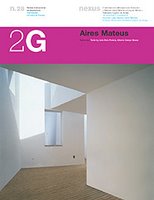
2G N.28 --Aires Mateus
Joao Belo Rodeia, Alberto Campo Baeza (texts)
ISBN: 84-252-1945-0
The architects Francisco and Manuel Aires Mateus occupy an important and well-deserved place on the current Portuguese architecture scene. The sheer quantity of their public and private commissions, the competitions won over the last few years, the countless prizes received and the publicizing of their buildings at the international level are all signs of the recognition of their work. This issue of 2G is the first monograph on the work of these Lisbon brothers and opens with a text by the critic Joao Belo Rodeia, a commentary by Alberto Campo Baeza on the house in Alenquer and an "informal conversation" with their teacher Gonnalo Byrne and Valentino Capelo de Sousa. Among the buildings presented one might single out the magnificent students' residence on the Coimbra University campus, the Universidade Nova de Lisboa rector's office or their splendid experiments in single-family housing, plus the rehabilitation of a ruined house in Alenquer, the Alvalade patio-house, the weekend house on the coast at Alentejo or the conversion of a former wine warehouse into housing in Brejos de Azeitao, all of these in Portugal.
+:+:+:+:+:+:+:+:+:+:+:+:+:+:+:+:+:+:+:+:+:+:+:+:+:+:+:+:++:+:+:+:+:+:+
Book bought:
-
Books read:
-Informal--Cecil Balmond
-2G Magazine Number 28--Aires Mateus
Monday, September 25, 2006
Being and Time
2006-09-25
“มันเป็นนาฟิกาของปู่ เมื่อพ่อยกให้ผม พ่อพูดว่า เควนติน พ่อขอยกสุสานแห่งความหวังและความปรารถนานี้ให้กับแก…พ่อมอบนาฬิกาเรือนนี้ให้กับแก ไม่ใช่เพื่อให้แกระลึกถึงมัน แต่เพื่อให้แกรู้จักที่จะลืมมันเสียบ้างเป็นครั้งคราว และเลิกทุ่มเททุกลมหายใจของแกพยายามเอาชนะมัน"
The Sound and the Fury--William Faulkner
-1-
เวลาเป็นจุดเริ่มต้นของหลายสิ่งหลายอย่างในชีวิต เวลาสร้างระยะห่างให้กับจุดสองจุด สร้างระยะห่างให้เหตุการณ์สองเหตุการณ์ สร้างความรู้สึกผูกพันให้คนสองคน เวลาสร้างความรักและความสุขให้แก่ชีวิต ในขณะเดียวกันเวลาก็สร้างความเกลียดชังและความเศร้า เวลานั้นเกิดขึ้นพร้อมกับสำนึกของการมีตัวตนซึ่งดำรงอยู่ในโลกของเรา ซึ่งในการมีตัวตนและดำรงอยู่นั้น ขณะที่ร่างกายกินพื้นที่บนผิวโลก เวลานั้นกลับกินพื้นที่อยู่ในความทรงจำ เวลาสร้างชิ้นส่วนของความเจ็บปวดที่ยากจะลืมเลือนให้กับชีวิต ขณะเดียวกันเวลาก็ประทับความรื่นรมย์ ความสุขไว้ในความทรงจำ จากนั้นก็เดินจากพร้อมกับทิ้งร่องรอยของมันเอาไว้ ให้เราระลึกถึง ให้เราถวิลถึง และอยู่กับร่องรอยที่ประทับอยู่ในความทรงจำด้วยความอาวรณ์ ด้วยเราไม่สามารถเดินทางย้อนกลับไปสู่สิ่งนั้น ในห้วงเวลาเดิมๆ
ดังนั้นในความทรงจำของเราจึงเต็มไปด้วยร่องรอย
รอยของกาลเวลาที่ประทับลงบนชีวิต
...
"ในชั่วพริบตาที่เข็มวินาทีกระดิกตัวเคลื่อน
เก้าอี้เบื้องหน้าและรอบตัวพลันว่างเปล่า
แก้วเหล้าบนโต๊ะหลงเหลือเพียงรอยนิ้วมือสัมผัสจากเจ้าของคนสุดท้าย
สองตาผู้คนที่เคยสบตา
เสียงพูดคุยที่เคยพุ่งตรงเข้าสองหู
และรอยยิ้มนั้นมิใช่หรือ ที่เคยวิ่งกระทบหัวใจ
พลันว่างเปล่า
เมื่อคำอำลาที่เอ่ยระหว่างกันและกันกำลังจะจบลง
ผมยิ่งแน่ใจว่ายังไม่อยากละทิ้งมันไป
สถานที่และเวลาผ่าน มันช่างทรงเสน่ห์
ความสุขความทรงจำยังคงลอยควะคว้างอ้อยอิ่งให้สัมผัสเบื้องหน้า
และแล้ว เมื่อคนสุดท้ายเอ่ยคำอำลา
ผมสบตาเขาและเธอ กล่าวคำว่าลาก่อน
ได้โปรดทิ้งผมไว้ที่นี่
ปลอบใจกับตัวเองว่า-ไม่เป็นไรหรอก, ผมยังมีหนังสืออีกหลายเล่มในกระเป๋า
ช่างมันเถอะ มันก็แค่เพียงอีกครั้งหนึ่ง
ที่ผมต้องเรียนรู้กับการอยู่ลำพังบนโลก" (1)
-2-
แต่ในทางกลับกันเวลานั้นไม่อาจสร้างรอยประทับในความทรงจำของสิ่งใดๆได้ ถ้าสิ่งนั้นไม่มีความสามารถที่จะจำ แต่สิ่งที่มีความสามารถที่จะจำได้นั้นต้องเป็นสิ่งที่มีจิต(consciousness) เพราะมีเพียงจิตเท่านั้นที่สามารถคิดและจดจำได้ แต่ก็ไม่มีจิตใดที่ดำรงอยู่ได้โดยปราศจากร่างกาย(body) เพราะจิตย่อมรับรู้สิ่งต่างๆ ผ่านประสาทสัมผัสทั้งห้าของร่างกาย คือ ตา หู จมูก ลิ้น และกายประสาท เพราะลำพังเพียงจิตอย่างเดียวนั้นไม่สามารถสัมผัสโลกที่อยู่รอบตัวได้จึงจำเป็นต้องมีร่างกายเป็นตัวเชื่อม ร่างกายจึงเชื่อมโยงจิตเข้ากับปริมณฑลของวัตถุ ดังนั้นในกระบวนการของการดำรงอยู่ของชีวิตใดๆ ก็ตาม ย่อมประกอบไปด้วยสิ่งที่เป็นกายและจิต ซึ่งนักปรัชญาสายอัตถิภาวะนิยม(existentialism) เรียกกระบวนการของการดำรงอยู่นี้ว่า ภาวะในโลก (Being-in-the-World)
และ ภาวะในโลก (Being-in-the-World) นี่เองที่ทำให้โลก, สรรพสิ่งและชีวิตปรากฏต่อจิตของเราในกรอบของพื้นที่และเวลา(space and time) ทำให้ปริมณฑลของวัตถุทางกายภาพปรากฏให้เห็นเป็นรูปธรรม และเมื่อความเป็นรูปธรรมปรากฏ วัตถุนั้นๆก็มีตำแหน่งแห่งที่อยู่ในโลก และด้วยกรอบความคิดหรือโลกทัศน์แบบวิทยาศาสตร์ เราสามารถกำหนดจุดตำแหน่งที่ตั้งหรือวัดขนาด ของวัตถุทางกายภาพใดๆด้วยการวัดระยะของวัตถุใน 3 ทิศทาง เป็นลักษณะ 3 มิติ คือมีกว้าง ยาว และสูง และสิ่งที่เป็นวัตถุทางกายภาพนั้น มีลักษณะที่สามารถกินพื้นที่บนผิวโลก ซึ่งระยะทางหรือช่องว่างระหว่างการกินพื้นที่ของวัตถุทางกายภาพนั้น เราเรียกมันว่า "ที่ว่าง" หรือ "พื้นที่" (space)
ฌอง-ปอล ซาตร์(Jean-Paul Sartre) นักปรัชญาสายอัตถิภาวะนิยม(existentialism) ชาวฝรั่งเศส เรียกความสามารถกินที่บนผิวโลกของวัตถุกายภาพนี้ว่า ความมีภาวะ(being) ซึ่งซาตร์ ได้อธิบายความคิดของเขาในเรื่องนี้ไว้ว่า ในโลกนี้ มีความมีภาวะอยู่ 2 ประเภท คือ ภาวะในตัวเอง(Being-in-it-self) ก็คือสิ่งที่ดำรงอยู่บนโลกโดยไม่มีจิต(non-consciousness) และ ภาวะสำหรับตัวเอง (Being-for-it-self) ก็คือสิ่งที่ดำรงอยู่บนโลกโดยมีจิต(consciousness)
วัตถุที่ไม่มีจิตนั้นย่อมมีความเต็มอยู่ในตัวเอง เป็นสสาร เป็นก้อนหิน เป็นโต๊ะสักตัว เป็นเสาไฟฟ้าสักต้น หรือเป็นขนมเค้กสักชิ้น ซึ่งตลอดเวลาที่มันดำรงอยู่มันไม่มีความสามารถที่จะเปลี่ยนตัวเองให้เป็นอย่างอื่น ไม่มีความสามารถที่แม้แต่ที่จะคิด แก่นสารของสิ่งของต่างๆเหล่านี้จึงดำรงอยู่ติดตัวมันอย่างถาวร แต่มนุษย์เรานั้นต่างจากสิ่งต่างๆ ทั้งหมดที่กล่าวมา เพราะมนุษย์ไร้แก่นสารและมีความว่างเปล่าอยู่ภายใน ซึ่งซาตร์ เชื่อว่าในความเป็นมนุษย์นั้น การดำรงอยู่มีอยู่ก่อนแก่นสาร(Existence preccedes essence) ดังนั้นเริ่มแรกของการดำรงอยู่มนุษย์จึงไม่มีตัวตนถาวร ตัวตนของมนุษย์นั้นขึ้นหลังจากที่มนุษย์เลือกที่จะกระทำหรือเลือกที่จะเป็นสิ่งใดสักอย่างหนึ่ง และเมื่อมนุษย์มีความสามารถที่จะเลือกดังนั้น มนุษย์จึงมี เสรีภาพ(freedom) ซึ่งความหมายของเสรีภาพในที่นี้ซาตร์ได้อธิบายเอาไว้ว่า “เสรีภาพมิได้หมายถึง ความสัมฤทธิผลของการตัดสินใจเลือกว่าเราจะทำสิ่งนี้แล้วต้องสำเร็จ เสรีภาพอยู่ที่ความสามารถในการตัดสินใจเลือก” มนุษย์จึงมีความสามารถที่จะเลือกหรือตัดสินใจทำหรือไม่ทำในสิ่งใดก็ได้ แต่มนุษย์ไม่มีความสามารถที่จะเลือกให้เลิกมีเสรีภาพได้ เพราะมนุษย์ถูกสาบให้มีเสรีภาพ(Man is Condemned to be free) และการเลือกของมนุษย์นั้นนำมาซึ่งความรับผิดชอบในสิ่งที่ตนได้เลือก…
"บุษบาบันไม่อยากตัดสินใจผิด ไม่ต้องการเสียใจไปตลอดชีวิต ทางไหนหนอที่เลือกแล้วพบความสุข บางครั้งชีวิตไม่ต่างกับการเลือกเที่ยวบินโดยสาร เลือกถูกมีความสุข เลือกผิดมีความทุกข์ ไม่ว่าสุขหรือทุกข์-ชีวิตต้องดำเนินไป เหมือนในกระเป๋ามีตั๋วเที่ยวเดียว เลือกเครื่องบินลำใดต้องอยู่ลำนั้น ลงหรือเปลี่ยนเครื่องกลางอากาศไม่ได้
แต่คนคนหนึ่งจะเลือกขึ้นเครื่องบินได้อย่างไร เมื่อ:
-ดูภายนอก เครื่องบินทุกลำสวยเป็นเงางามกลางแดดบนลานจอด(บางลำระบายแถบสีม่วงข้างตัวถัง บ้างสีเขียว บ้างสีชมพู)
-สายการบินของเครื่องบินแต่ละลำโฆษณาว่าเครื่องของตนสมรรถนะสูง สะดวกสบาย
-เครื่องบินทุกลำประกาศว่าจะบินจาก “ปัจจุบัน” ไป “อนาคตอันแสนสุข”
-คนคนนั้นไม่เชื่อคำแนะนำของผู้มีประสบการณ์
สิ่งที่คนคนนั้นต้องการที่สุดสำหรับตัดสินใจ คือ The Thin Red Line-เส้นบางสีแดง ซึ่งเทพเจ้าขีดเตือนว่าหากเห็นเส้นบางสีแดง ต้องเปลี่ยนไปทางอื่น อย่าล้ำเส้น มิฉะนั้นจะถลำสู่ความทุกข์
คนเลือกเครื่องบินทราบว่าไม่ควรโดยสารไปกับเครื่องบินที่ระบายแถบสีม่วงข้างตัวถัง ถ้าเห็นเส้นบางสีแดงบนพื้นหน้าประตูทางขึ้น
………
เราไม่เคลือบแคลงเทพเจ้า พระองค์เห็นอนาคต รู้ทุกสิ่งในจักรวาล
………
ทว่าเทพเจ้าไม่เคยขีดเส้นบางสีแดงให้เห็น(แม้เปิดไฟฉายแม็กซ์ไลท์ส่อง-ใส่แว่นอินฟราเรดที่ใช้มองในความมืด-ตรวจจับด้วยรังสีเอ็กซ์เรย์) มนุษย์ต้องตรองตัดสินใจเอง
บางคนท้วงว่าเทพเจ้าไม่เคยขีดเส้นบางสีแดงให้เราเห็นด้วยตาแต่สามารถเห็นด้วยใจหากศรัทธาศาสนา และรู้สึกได้ด้วยสัญชาตญาณระวังภัยที่อยู่ในยีน(gene)
ทว่าโลกยุค 2001 ความเสื่อมศีลธรรมของพระกับนักบวชทำให้เรากังขาคำสอนของพระศาสนา
ความไร้จริยธรรมของผู้ใหญ่-ผู้มีประสบการณ์ทำให้เราไม่เชื่อคำแนะนำ(หนังสือพิมพ์รายงานข่าวนายกรัฐมนตรีพูดเท็จ รองประธานวุฒิสภาลวนลามทางเพศเด็กหญิง 5 คน ฯลฯ)
แสงไฟ ตึกระฟ้า อิทธิพลการโฆษณากับการสร้างภาพมายาในสังคมมหานคร(society of metropolis) ทำให้สัญชาตญาณระวังภัยของเราสับสน คลายความแม่น ความผิด-ถูก-ดี-ร้ายปรากฏในรูปโฉมเดียวกัน(นมผงผสมน้ำโฆษณา-เขียนข้างกล่องว่านมโคสดแท้ พระราชาเป่าทรอมโบนเพลงบลูส์แจ๊สที่มีต้นกำเนิดมาจากทาสนิโกร วงดนตรีออร์เคสตร้าบรรเลงเพลงร็อคแอนด์โรล เครื่องบินทุกลำได้รับการพ่นสีระบายแถบข้างตัวถังสวยเป็นเงางามกลางแดดบนลานจอด….)
สิ่งที่เห็นวันนี้ คือคนทุกข์เพราะตัดสินใจผิดนับล้านล้านกับคนคิดไปลำพังอย่างมืดบอด-หวังจะไม่เป็นอย่างพวกแรก-อีกนับล้านล้าน
คนประเภทแรกก่อโศกนาฎกรรมทุกอย่างบนโลก
(เด็กหนุ่มจำนวนมากตัดสินใจเป็นทหารกล้าเหมือนพลทหารในหนัง The Thin Red Line เขาพบว่าทางที่เลือกทำให้เขาเป็นเครื่องจักรฆ่าคน เขาทรมาน แต่หยุดไม่ได้ นิตยสารเอเซียวีค-เดือนกุมภาพันธ์ 2544 ตีพิมพ์รูปทหารปากีสถาน 441 นาย สวมชุดขนสัตว์-ถือปืนกล นั่งเฮลิคอปเตอร์ตระเวนบนภูเขาหิมาลัยซึ่งปกคลุมด้วยหิมะขาวโพลน เตรียมยิงชาวอินเดียทุกคนที่เจอ ทหารปากีสถานบางคนไม่อยากทำ ทว่าการเป็นทหารกล้าต้องปฏิบัติหน้าที่ที่ผู้บังคับบัญชามอบหมาย)
คนประเภทหลังอ้างว้าง ลังเล (2)
เมื่อเสรีภาพนำเรามาถึงทางแพร่ง ทางแพร่งที่เราต้องเลือกที่จะเดินทางผ่าน ในขณะที่ชีวิตเรากำลังดำรงอยู่ในโลก พื้นที่ทางความคิดและพื้นที่ทางกายภาพแห่งใดที่เราจะเลือกเดินไป ในห้วงเวลาที่ยังมาไม่ถึง ซาตร์บอกว่าชีวิตคือความว่างเปล่า(emptiness) และคุณก็มีเสรีภาพที่ค้นหาตัวตนของคุณด้วยตัวของคุณเอง แต่สถานที่แห่งไหนและเวลาใดในโลกใบนี้ล่ะที่เราจะพบตัวตนของเรา ซาตร์เดินจูงมือเรามาถึงที่โล่งที่กว้างใหญ่ไพศาลไร้ขอบเขต จากนั้นก็ปล่อยมือเรา แล้วพูดว่า “เส้นทางเดินจากนี้ไปแล้วแต่คุณ” จากนั้นเขาก็จากไป ถ้าเรามองไปรอบตัวจะเห็นว่าเราสามารถเคลื่อนที่ไปได้ในทุกทิศทาง
แต่เราจะใช้เกณฑ์ใดในการที่จะตัดสินใจเคลื่อนที่ไปในทิศทางไหน ความรู้ ความเชื่อ ศรัทธา สัญชาตญาณ เหตุผล อุดมการณ์ทางการเมือง หรือ ความรัก ความเมตากรุณาและมิตรภาพ
และเราจะมั่นใจได้อย่างไรว่าตัวตนของเราที่เรากำลังเดินทางค้นหาเพื่อมาเติมส่วนที่ว่างเปล่า(emptiness) ของชีวิตนั้น
มีอยู่จริง?
หมายเหตุ : ผมนั่งเขียนเรื่องนี้ อยู่ในเมืองๆ หนึ่ง เมืองที่ปกคลุมไปด้วยหมอก ซึ่งทุกอย่างดูมัวซัว และไม่ชัดเจน แต่ผู้คนในเมืองก็ต่างเต็มไปด้วยรอยยิ้ม และมีความหวังว่าท้องฟ้าจะกลับมาสดใสอีกครั้ง เมืองประหลาดที่ดอกไม้บานทุกดอกกำลังบานสะพรั่งท่ามกลางบรรยากาศที่แสนจะพร่ามัว
+:+:+:+:+:+:+:+:+:+:+:+:+:+:+:+:+:+:+:+:+:+:+:+:+:+:+:+:++:+:+:+:+:+:+

รวมเรื่องสั้น "เรื่องรักธรรมดา"
ISBN: 974-87957-0-5
หมายเหตุ:
(1) จากเรื่องสั้นเรื่อง "หนาวเช้า" เขียนโดย คมสัน นันทจิต
(2) จากเรื่องสั้นเรื่อง "ทัชมาฮาล" เขียนโดย ทินกร หุตางกูร
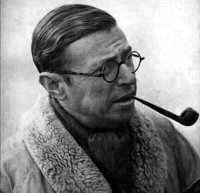
ข้อมูลที่เกี่ยวกับ ฌอง-ปอล ซาตร์(Jean-Paul Sartre)
สามารถดูได้ที่:-
http://nobelprize.org/nobel_prizes/literature/laureates/1964/sartre-bio.html
+:+:+:+:+:+:+:+:+:+:+:+:+:+:+:+:+:+:+:+:+:+:+:+:+:+:+:+:++:+:+:+:+:+:+
Book bought:
-
Books read:
-Informal--Cecil Balmond
-นิตยสารสารคดี ฉบับที่ 259--กันยายน 2549
-2G Magazine Number 28--Aires Mateus
“มันเป็นนาฟิกาของปู่ เมื่อพ่อยกให้ผม พ่อพูดว่า เควนติน พ่อขอยกสุสานแห่งความหวังและความปรารถนานี้ให้กับแก…พ่อมอบนาฬิกาเรือนนี้ให้กับแก ไม่ใช่เพื่อให้แกระลึกถึงมัน แต่เพื่อให้แกรู้จักที่จะลืมมันเสียบ้างเป็นครั้งคราว และเลิกทุ่มเททุกลมหายใจของแกพยายามเอาชนะมัน"
The Sound and the Fury--William Faulkner
-1-
เวลาเป็นจุดเริ่มต้นของหลายสิ่งหลายอย่างในชีวิต เวลาสร้างระยะห่างให้กับจุดสองจุด สร้างระยะห่างให้เหตุการณ์สองเหตุการณ์ สร้างความรู้สึกผูกพันให้คนสองคน เวลาสร้างความรักและความสุขให้แก่ชีวิต ในขณะเดียวกันเวลาก็สร้างความเกลียดชังและความเศร้า เวลานั้นเกิดขึ้นพร้อมกับสำนึกของการมีตัวตนซึ่งดำรงอยู่ในโลกของเรา ซึ่งในการมีตัวตนและดำรงอยู่นั้น ขณะที่ร่างกายกินพื้นที่บนผิวโลก เวลานั้นกลับกินพื้นที่อยู่ในความทรงจำ เวลาสร้างชิ้นส่วนของความเจ็บปวดที่ยากจะลืมเลือนให้กับชีวิต ขณะเดียวกันเวลาก็ประทับความรื่นรมย์ ความสุขไว้ในความทรงจำ จากนั้นก็เดินจากพร้อมกับทิ้งร่องรอยของมันเอาไว้ ให้เราระลึกถึง ให้เราถวิลถึง และอยู่กับร่องรอยที่ประทับอยู่ในความทรงจำด้วยความอาวรณ์ ด้วยเราไม่สามารถเดินทางย้อนกลับไปสู่สิ่งนั้น ในห้วงเวลาเดิมๆ
ดังนั้นในความทรงจำของเราจึงเต็มไปด้วยร่องรอย
รอยของกาลเวลาที่ประทับลงบนชีวิต
...
"ในชั่วพริบตาที่เข็มวินาทีกระดิกตัวเคลื่อน
เก้าอี้เบื้องหน้าและรอบตัวพลันว่างเปล่า
แก้วเหล้าบนโต๊ะหลงเหลือเพียงรอยนิ้วมือสัมผัสจากเจ้าของคนสุดท้าย
สองตาผู้คนที่เคยสบตา
เสียงพูดคุยที่เคยพุ่งตรงเข้าสองหู
และรอยยิ้มนั้นมิใช่หรือ ที่เคยวิ่งกระทบหัวใจ
พลันว่างเปล่า
เมื่อคำอำลาที่เอ่ยระหว่างกันและกันกำลังจะจบลง
ผมยิ่งแน่ใจว่ายังไม่อยากละทิ้งมันไป
สถานที่และเวลาผ่าน มันช่างทรงเสน่ห์
ความสุขความทรงจำยังคงลอยควะคว้างอ้อยอิ่งให้สัมผัสเบื้องหน้า
และแล้ว เมื่อคนสุดท้ายเอ่ยคำอำลา
ผมสบตาเขาและเธอ กล่าวคำว่าลาก่อน
ได้โปรดทิ้งผมไว้ที่นี่
ปลอบใจกับตัวเองว่า-ไม่เป็นไรหรอก, ผมยังมีหนังสืออีกหลายเล่มในกระเป๋า
ช่างมันเถอะ มันก็แค่เพียงอีกครั้งหนึ่ง
ที่ผมต้องเรียนรู้กับการอยู่ลำพังบนโลก" (1)
-2-
แต่ในทางกลับกันเวลานั้นไม่อาจสร้างรอยประทับในความทรงจำของสิ่งใดๆได้ ถ้าสิ่งนั้นไม่มีความสามารถที่จะจำ แต่สิ่งที่มีความสามารถที่จะจำได้นั้นต้องเป็นสิ่งที่มีจิต(consciousness) เพราะมีเพียงจิตเท่านั้นที่สามารถคิดและจดจำได้ แต่ก็ไม่มีจิตใดที่ดำรงอยู่ได้โดยปราศจากร่างกาย(body) เพราะจิตย่อมรับรู้สิ่งต่างๆ ผ่านประสาทสัมผัสทั้งห้าของร่างกาย คือ ตา หู จมูก ลิ้น และกายประสาท เพราะลำพังเพียงจิตอย่างเดียวนั้นไม่สามารถสัมผัสโลกที่อยู่รอบตัวได้จึงจำเป็นต้องมีร่างกายเป็นตัวเชื่อม ร่างกายจึงเชื่อมโยงจิตเข้ากับปริมณฑลของวัตถุ ดังนั้นในกระบวนการของการดำรงอยู่ของชีวิตใดๆ ก็ตาม ย่อมประกอบไปด้วยสิ่งที่เป็นกายและจิต ซึ่งนักปรัชญาสายอัตถิภาวะนิยม(existentialism) เรียกกระบวนการของการดำรงอยู่นี้ว่า ภาวะในโลก (Being-in-the-World)
และ ภาวะในโลก (Being-in-the-World) นี่เองที่ทำให้โลก, สรรพสิ่งและชีวิตปรากฏต่อจิตของเราในกรอบของพื้นที่และเวลา(space and time) ทำให้ปริมณฑลของวัตถุทางกายภาพปรากฏให้เห็นเป็นรูปธรรม และเมื่อความเป็นรูปธรรมปรากฏ วัตถุนั้นๆก็มีตำแหน่งแห่งที่อยู่ในโลก และด้วยกรอบความคิดหรือโลกทัศน์แบบวิทยาศาสตร์ เราสามารถกำหนดจุดตำแหน่งที่ตั้งหรือวัดขนาด ของวัตถุทางกายภาพใดๆด้วยการวัดระยะของวัตถุใน 3 ทิศทาง เป็นลักษณะ 3 มิติ คือมีกว้าง ยาว และสูง และสิ่งที่เป็นวัตถุทางกายภาพนั้น มีลักษณะที่สามารถกินพื้นที่บนผิวโลก ซึ่งระยะทางหรือช่องว่างระหว่างการกินพื้นที่ของวัตถุทางกายภาพนั้น เราเรียกมันว่า "ที่ว่าง" หรือ "พื้นที่" (space)
ฌอง-ปอล ซาตร์(Jean-Paul Sartre) นักปรัชญาสายอัตถิภาวะนิยม(existentialism) ชาวฝรั่งเศส เรียกความสามารถกินที่บนผิวโลกของวัตถุกายภาพนี้ว่า ความมีภาวะ(being) ซึ่งซาตร์ ได้อธิบายความคิดของเขาในเรื่องนี้ไว้ว่า ในโลกนี้ มีความมีภาวะอยู่ 2 ประเภท คือ ภาวะในตัวเอง(Being-in-it-self) ก็คือสิ่งที่ดำรงอยู่บนโลกโดยไม่มีจิต(non-consciousness) และ ภาวะสำหรับตัวเอง (Being-for-it-self) ก็คือสิ่งที่ดำรงอยู่บนโลกโดยมีจิต(consciousness)
วัตถุที่ไม่มีจิตนั้นย่อมมีความเต็มอยู่ในตัวเอง เป็นสสาร เป็นก้อนหิน เป็นโต๊ะสักตัว เป็นเสาไฟฟ้าสักต้น หรือเป็นขนมเค้กสักชิ้น ซึ่งตลอดเวลาที่มันดำรงอยู่มันไม่มีความสามารถที่จะเปลี่ยนตัวเองให้เป็นอย่างอื่น ไม่มีความสามารถที่แม้แต่ที่จะคิด แก่นสารของสิ่งของต่างๆเหล่านี้จึงดำรงอยู่ติดตัวมันอย่างถาวร แต่มนุษย์เรานั้นต่างจากสิ่งต่างๆ ทั้งหมดที่กล่าวมา เพราะมนุษย์ไร้แก่นสารและมีความว่างเปล่าอยู่ภายใน ซึ่งซาตร์ เชื่อว่าในความเป็นมนุษย์นั้น การดำรงอยู่มีอยู่ก่อนแก่นสาร(Existence preccedes essence) ดังนั้นเริ่มแรกของการดำรงอยู่มนุษย์จึงไม่มีตัวตนถาวร ตัวตนของมนุษย์นั้นขึ้นหลังจากที่มนุษย์เลือกที่จะกระทำหรือเลือกที่จะเป็นสิ่งใดสักอย่างหนึ่ง และเมื่อมนุษย์มีความสามารถที่จะเลือกดังนั้น มนุษย์จึงมี เสรีภาพ(freedom) ซึ่งความหมายของเสรีภาพในที่นี้ซาตร์ได้อธิบายเอาไว้ว่า “เสรีภาพมิได้หมายถึง ความสัมฤทธิผลของการตัดสินใจเลือกว่าเราจะทำสิ่งนี้แล้วต้องสำเร็จ เสรีภาพอยู่ที่ความสามารถในการตัดสินใจเลือก” มนุษย์จึงมีความสามารถที่จะเลือกหรือตัดสินใจทำหรือไม่ทำในสิ่งใดก็ได้ แต่มนุษย์ไม่มีความสามารถที่จะเลือกให้เลิกมีเสรีภาพได้ เพราะมนุษย์ถูกสาบให้มีเสรีภาพ(Man is Condemned to be free) และการเลือกของมนุษย์นั้นนำมาซึ่งความรับผิดชอบในสิ่งที่ตนได้เลือก…
"บุษบาบันไม่อยากตัดสินใจผิด ไม่ต้องการเสียใจไปตลอดชีวิต ทางไหนหนอที่เลือกแล้วพบความสุข บางครั้งชีวิตไม่ต่างกับการเลือกเที่ยวบินโดยสาร เลือกถูกมีความสุข เลือกผิดมีความทุกข์ ไม่ว่าสุขหรือทุกข์-ชีวิตต้องดำเนินไป เหมือนในกระเป๋ามีตั๋วเที่ยวเดียว เลือกเครื่องบินลำใดต้องอยู่ลำนั้น ลงหรือเปลี่ยนเครื่องกลางอากาศไม่ได้
แต่คนคนหนึ่งจะเลือกขึ้นเครื่องบินได้อย่างไร เมื่อ:
-ดูภายนอก เครื่องบินทุกลำสวยเป็นเงางามกลางแดดบนลานจอด(บางลำระบายแถบสีม่วงข้างตัวถัง บ้างสีเขียว บ้างสีชมพู)
-สายการบินของเครื่องบินแต่ละลำโฆษณาว่าเครื่องของตนสมรรถนะสูง สะดวกสบาย
-เครื่องบินทุกลำประกาศว่าจะบินจาก “ปัจจุบัน” ไป “อนาคตอันแสนสุข”
-คนคนนั้นไม่เชื่อคำแนะนำของผู้มีประสบการณ์
สิ่งที่คนคนนั้นต้องการที่สุดสำหรับตัดสินใจ คือ The Thin Red Line-เส้นบางสีแดง ซึ่งเทพเจ้าขีดเตือนว่าหากเห็นเส้นบางสีแดง ต้องเปลี่ยนไปทางอื่น อย่าล้ำเส้น มิฉะนั้นจะถลำสู่ความทุกข์
คนเลือกเครื่องบินทราบว่าไม่ควรโดยสารไปกับเครื่องบินที่ระบายแถบสีม่วงข้างตัวถัง ถ้าเห็นเส้นบางสีแดงบนพื้นหน้าประตูทางขึ้น
………
เราไม่เคลือบแคลงเทพเจ้า พระองค์เห็นอนาคต รู้ทุกสิ่งในจักรวาล
………
ทว่าเทพเจ้าไม่เคยขีดเส้นบางสีแดงให้เห็น(แม้เปิดไฟฉายแม็กซ์ไลท์ส่อง-ใส่แว่นอินฟราเรดที่ใช้มองในความมืด-ตรวจจับด้วยรังสีเอ็กซ์เรย์) มนุษย์ต้องตรองตัดสินใจเอง
บางคนท้วงว่าเทพเจ้าไม่เคยขีดเส้นบางสีแดงให้เราเห็นด้วยตาแต่สามารถเห็นด้วยใจหากศรัทธาศาสนา และรู้สึกได้ด้วยสัญชาตญาณระวังภัยที่อยู่ในยีน(gene)
ทว่าโลกยุค 2001 ความเสื่อมศีลธรรมของพระกับนักบวชทำให้เรากังขาคำสอนของพระศาสนา
ความไร้จริยธรรมของผู้ใหญ่-ผู้มีประสบการณ์ทำให้เราไม่เชื่อคำแนะนำ(หนังสือพิมพ์รายงานข่าวนายกรัฐมนตรีพูดเท็จ รองประธานวุฒิสภาลวนลามทางเพศเด็กหญิง 5 คน ฯลฯ)
แสงไฟ ตึกระฟ้า อิทธิพลการโฆษณากับการสร้างภาพมายาในสังคมมหานคร(society of metropolis) ทำให้สัญชาตญาณระวังภัยของเราสับสน คลายความแม่น ความผิด-ถูก-ดี-ร้ายปรากฏในรูปโฉมเดียวกัน(นมผงผสมน้ำโฆษณา-เขียนข้างกล่องว่านมโคสดแท้ พระราชาเป่าทรอมโบนเพลงบลูส์แจ๊สที่มีต้นกำเนิดมาจากทาสนิโกร วงดนตรีออร์เคสตร้าบรรเลงเพลงร็อคแอนด์โรล เครื่องบินทุกลำได้รับการพ่นสีระบายแถบข้างตัวถังสวยเป็นเงางามกลางแดดบนลานจอด….)
สิ่งที่เห็นวันนี้ คือคนทุกข์เพราะตัดสินใจผิดนับล้านล้านกับคนคิดไปลำพังอย่างมืดบอด-หวังจะไม่เป็นอย่างพวกแรก-อีกนับล้านล้าน
คนประเภทแรกก่อโศกนาฎกรรมทุกอย่างบนโลก
(เด็กหนุ่มจำนวนมากตัดสินใจเป็นทหารกล้าเหมือนพลทหารในหนัง The Thin Red Line เขาพบว่าทางที่เลือกทำให้เขาเป็นเครื่องจักรฆ่าคน เขาทรมาน แต่หยุดไม่ได้ นิตยสารเอเซียวีค-เดือนกุมภาพันธ์ 2544 ตีพิมพ์รูปทหารปากีสถาน 441 นาย สวมชุดขนสัตว์-ถือปืนกล นั่งเฮลิคอปเตอร์ตระเวนบนภูเขาหิมาลัยซึ่งปกคลุมด้วยหิมะขาวโพลน เตรียมยิงชาวอินเดียทุกคนที่เจอ ทหารปากีสถานบางคนไม่อยากทำ ทว่าการเป็นทหารกล้าต้องปฏิบัติหน้าที่ที่ผู้บังคับบัญชามอบหมาย)
คนประเภทหลังอ้างว้าง ลังเล (2)
เมื่อเสรีภาพนำเรามาถึงทางแพร่ง ทางแพร่งที่เราต้องเลือกที่จะเดินทางผ่าน ในขณะที่ชีวิตเรากำลังดำรงอยู่ในโลก พื้นที่ทางความคิดและพื้นที่ทางกายภาพแห่งใดที่เราจะเลือกเดินไป ในห้วงเวลาที่ยังมาไม่ถึง ซาตร์บอกว่าชีวิตคือความว่างเปล่า(emptiness) และคุณก็มีเสรีภาพที่ค้นหาตัวตนของคุณด้วยตัวของคุณเอง แต่สถานที่แห่งไหนและเวลาใดในโลกใบนี้ล่ะที่เราจะพบตัวตนของเรา ซาตร์เดินจูงมือเรามาถึงที่โล่งที่กว้างใหญ่ไพศาลไร้ขอบเขต จากนั้นก็ปล่อยมือเรา แล้วพูดว่า “เส้นทางเดินจากนี้ไปแล้วแต่คุณ” จากนั้นเขาก็จากไป ถ้าเรามองไปรอบตัวจะเห็นว่าเราสามารถเคลื่อนที่ไปได้ในทุกทิศทาง
แต่เราจะใช้เกณฑ์ใดในการที่จะตัดสินใจเคลื่อนที่ไปในทิศทางไหน ความรู้ ความเชื่อ ศรัทธา สัญชาตญาณ เหตุผล อุดมการณ์ทางการเมือง หรือ ความรัก ความเมตากรุณาและมิตรภาพ
และเราจะมั่นใจได้อย่างไรว่าตัวตนของเราที่เรากำลังเดินทางค้นหาเพื่อมาเติมส่วนที่ว่างเปล่า(emptiness) ของชีวิตนั้น
มีอยู่จริง?
หมายเหตุ : ผมนั่งเขียนเรื่องนี้ อยู่ในเมืองๆ หนึ่ง เมืองที่ปกคลุมไปด้วยหมอก ซึ่งทุกอย่างดูมัวซัว และไม่ชัดเจน แต่ผู้คนในเมืองก็ต่างเต็มไปด้วยรอยยิ้ม และมีความหวังว่าท้องฟ้าจะกลับมาสดใสอีกครั้ง เมืองประหลาดที่ดอกไม้บานทุกดอกกำลังบานสะพรั่งท่ามกลางบรรยากาศที่แสนจะพร่ามัว
+:+:+:+:+:+:+:+:+:+:+:+:+:+:+:+:+:+:+:+:+:+:+:+:+:+:+:+:++:+:+:+:+:+:+

รวมเรื่องสั้น "เรื่องรักธรรมดา"
ISBN: 974-87957-0-5
หมายเหตุ:
(1) จากเรื่องสั้นเรื่อง "หนาวเช้า" เขียนโดย คมสัน นันทจิต
(2) จากเรื่องสั้นเรื่อง "ทัชมาฮาล" เขียนโดย ทินกร หุตางกูร

ข้อมูลที่เกี่ยวกับ ฌอง-ปอล ซาตร์(Jean-Paul Sartre)
สามารถดูได้ที่:-
http://nobelprize.org/nobel_prizes/literature/laureates/1964/sartre-bio.html
+:+:+:+:+:+:+:+:+:+:+:+:+:+:+:+:+:+:+:+:+:+:+:+:+:+:+:+:++:+:+:+:+:+:+
Book bought:
-
Books read:
-Informal--Cecil Balmond
-นิตยสารสารคดี ฉบับที่ 259--กันยายน 2549
-2G Magazine Number 28--Aires Mateus
Sunday, September 24, 2006
Instant Light
2006-09-24
The image is not a certain meaning,
expressed by the director,
but the entire world
reflected as in a drop of water.

An artistic image
is one that ensures its own development,
its historical viability.
An image is a grain,
a self-evolving retroactive organism.
It is a symbol of actual life,
as opposed to life itself.
Life contains death.
An image of life, by contrast,
excludes it, or else sees in it
a unique potential
for the affirmation of life

Lord! I feel You drawing near,
I can feel Your hand upon the back of my head.
Because I want to see Your world
as You made it,
and Your people
as You would have them be,
I Love You, Lord,
and want nothing else from You.
I accept all that is Yours,
and only the weight of my malice and my sins,
the darkness of my base soul,
prevent me from being
Your worthy slave, O Lord!
Help me, Lord, and forgive me!

+:+:+:+:+:+:+:+:+:+:+:+:+:+:+:+:+:+:+:+:+:+:+:+:+:+:+:+:++:+:+:+:+:+:+

Instant Light: Tarkovsky Polaroids
Edited by Giovanni Chiaramonte and Andrey A. Tarkovsky
ISBN 0500286140
A beautiful, elegiac collection of sixty polaroid photographs by the late, great Soviet film director, Andrei Tarkovsky
‘Tarkovsky often reflected on the way that time flies and this is precisely what he wanted: to stop it, even with these quick Polaroid shots … These images leave us with a mysterious and poetic sensation, the melancholy of seeing things for the last time. It is as though Andrey wanted a swift way to pass his own enjoyment to others. They are something to be shared, not only a method of making his own wish to stop time come true. And they feel like a fond farewell’ – Tonino Guerra, from the Introduction to Instant Light
Composed of sixty luminous polaroids taken by Andrey Tarkovsky in Russia and Italy between 1979 and 1984, this beautifully produced series of cameos from the director’s life reveals him to be a master of the still as much as of the moving image. The photos in the first section, taken in Russia, have the radiant melancholy of lengthening shadows and trees looming through misty dawns near Tarkovsky’s country dacha, together with portraits of his wife, son and dog, loaded with nostalgia by quotations from his later diaries. Those taken in Italy portray exquisite still lifes and glimmering ruins. The book concludes with photographs from Tarkovsky’s personal collection.
Tarkovsky is here revealed as realizing the utmost potential of a fleeting, disposable medium: his images seem to capture eternity in a moment.
Andrei Tarkovsky, probably best-known for his 1972 film Solaris, is widely considered the finest film-maker Russia has ever produced. He died in 1986. Andrei A. Tarkovsky is his son. Giovanni Chiaramonte is a distinguished Italian photographer. Tonino Guerra is a prolific Italian screenwriter and was a great friend of Tarkovsky, with whom he worked on Nostalghia.
ソ連の孤高の映画監督、タルコフスキーによるフォトコレクション
それは優しい告別のようにも感じられる—ジョバンニ・キアラモンテ
アンドレイ・タルコフスキー(1932-1986)は、広大なロシアがかつて輩出した中で最も素晴らしいフィルムメーカーのひとりです。1972年に制作された「惑星ソラリス」が特に有名ですが、その他に「アンドレイ=ルブリョフ」「鏡」「ストーカー」などがあります。ソ連政府の検問と戦い続けた彼は、イタリアにおいて故郷への想いを込めた「ノスタルジア」を撮影し、ソ連からの亡命を宣言しました。晩年、政府から名誉回復の通達を受け、家族との再会が実現。その模様はNHKのドキュメンタリー番組でも放送されました。
本書には、タルコフスキーが1979年から1984年の間に、ロシアと亡命先であるイタリアで撮影したポラロイド62枚が収められています。イタリアの写真家ジョバンニ・キアラモンテと、タルコフスキーの息子が編集を担当しました。序文を寄せたトニーノ・グエッラはイタリアの映画脚本家で、タルコフスキーとは「ノスタルジア」で一緒に仕事をして以来の親友です。
ソ連時代に撮られた第1章では、彼が後に書いた日記からの引用によって郷愁の想いが綴られています。カントリー・ダーチャ(ロシアの別荘)で過ごす彼の妻、息子、犬の肖像。霧深い夜明けと共にぼんやりと現われる木や長い影が憂鬱さを放ちます。第2章のイタリア編は、前章とは対照的に精巧に静止している生活の一場面や、かすかに光る廃墟などが印象的です。
映画のワンシーンを彷彿とさせる写真が数多く見られ、映像にこだわり続けたタルコフスキーを偲ばせます。
+:+:+:+:+:+:+:+:+:+:+:+:+:+:+:+:+:+:+:+:+:+:+:+:+:+:+:+:++:+:+:+:+:+:+
Book bought:
-
Books read:
-Informal--Cecil Balmond
-Instant Light: Tarkovsky Polaroids--Edited by Giovanni Chiaramonte and Andrey A. Tarkovsky
The image is not a certain meaning,
expressed by the director,
but the entire world
reflected as in a drop of water.

An artistic image
is one that ensures its own development,
its historical viability.
An image is a grain,
a self-evolving retroactive organism.
It is a symbol of actual life,
as opposed to life itself.
Life contains death.
An image of life, by contrast,
excludes it, or else sees in it
a unique potential
for the affirmation of life

Lord! I feel You drawing near,
I can feel Your hand upon the back of my head.
Because I want to see Your world
as You made it,
and Your people
as You would have them be,
I Love You, Lord,
and want nothing else from You.
I accept all that is Yours,
and only the weight of my malice and my sins,
the darkness of my base soul,
prevent me from being
Your worthy slave, O Lord!
Help me, Lord, and forgive me!

+:+:+:+:+:+:+:+:+:+:+:+:+:+:+:+:+:+:+:+:+:+:+:+:+:+:+:+:++:+:+:+:+:+:+

Instant Light: Tarkovsky Polaroids
Edited by Giovanni Chiaramonte and Andrey A. Tarkovsky
ISBN 0500286140
A beautiful, elegiac collection of sixty polaroid photographs by the late, great Soviet film director, Andrei Tarkovsky
‘Tarkovsky often reflected on the way that time flies and this is precisely what he wanted: to stop it, even with these quick Polaroid shots … These images leave us with a mysterious and poetic sensation, the melancholy of seeing things for the last time. It is as though Andrey wanted a swift way to pass his own enjoyment to others. They are something to be shared, not only a method of making his own wish to stop time come true. And they feel like a fond farewell’ – Tonino Guerra, from the Introduction to Instant Light
Composed of sixty luminous polaroids taken by Andrey Tarkovsky in Russia and Italy between 1979 and 1984, this beautifully produced series of cameos from the director’s life reveals him to be a master of the still as much as of the moving image. The photos in the first section, taken in Russia, have the radiant melancholy of lengthening shadows and trees looming through misty dawns near Tarkovsky’s country dacha, together with portraits of his wife, son and dog, loaded with nostalgia by quotations from his later diaries. Those taken in Italy portray exquisite still lifes and glimmering ruins. The book concludes with photographs from Tarkovsky’s personal collection.
Tarkovsky is here revealed as realizing the utmost potential of a fleeting, disposable medium: his images seem to capture eternity in a moment.
Andrei Tarkovsky, probably best-known for his 1972 film Solaris, is widely considered the finest film-maker Russia has ever produced. He died in 1986. Andrei A. Tarkovsky is his son. Giovanni Chiaramonte is a distinguished Italian photographer. Tonino Guerra is a prolific Italian screenwriter and was a great friend of Tarkovsky, with whom he worked on Nostalghia.
ソ連の孤高の映画監督、タルコフスキーによるフォトコレクション
それは優しい告別のようにも感じられる—ジョバンニ・キアラモンテ
アンドレイ・タルコフスキー(1932-1986)は、広大なロシアがかつて輩出した中で最も素晴らしいフィルムメーカーのひとりです。1972年に制作された「惑星ソラリス」が特に有名ですが、その他に「アンドレイ=ルブリョフ」「鏡」「ストーカー」などがあります。ソ連政府の検問と戦い続けた彼は、イタリアにおいて故郷への想いを込めた「ノスタルジア」を撮影し、ソ連からの亡命を宣言しました。晩年、政府から名誉回復の通達を受け、家族との再会が実現。その模様はNHKのドキュメンタリー番組でも放送されました。
本書には、タルコフスキーが1979年から1984年の間に、ロシアと亡命先であるイタリアで撮影したポラロイド62枚が収められています。イタリアの写真家ジョバンニ・キアラモンテと、タルコフスキーの息子が編集を担当しました。序文を寄せたトニーノ・グエッラはイタリアの映画脚本家で、タルコフスキーとは「ノスタルジア」で一緒に仕事をして以来の親友です。
ソ連時代に撮られた第1章では、彼が後に書いた日記からの引用によって郷愁の想いが綴られています。カントリー・ダーチャ(ロシアの別荘)で過ごす彼の妻、息子、犬の肖像。霧深い夜明けと共にぼんやりと現われる木や長い影が憂鬱さを放ちます。第2章のイタリア編は、前章とは対照的に精巧に静止している生活の一場面や、かすかに光る廃墟などが印象的です。
映画のワンシーンを彷彿とさせる写真が数多く見られ、映像にこだわり続けたタルコフスキーを偲ばせます。
+:+:+:+:+:+:+:+:+:+:+:+:+:+:+:+:+:+:+:+:+:+:+:+:+:+:+:+:++:+:+:+:+:+:+
Book bought:
-
Books read:
-Informal--Cecil Balmond
-Instant Light: Tarkovsky Polaroids--Edited by Giovanni Chiaramonte and Andrey A. Tarkovsky
Saturday, September 23, 2006
OMANY
Dee & Charles Wyly Theater
2006-09-23
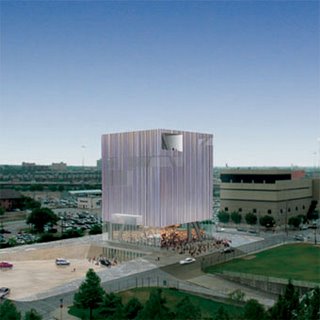
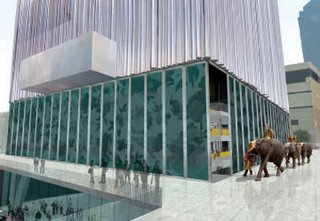



In a Typical Theather, the front-of-house and back-of-house function imprison the performance chamber.
By re-positioning all support spaces below-house and above-house, the Wyly Theater's chamber is liberated from captivity to engage the city around it. The entire building become one large fly tower, a "theater machine" that eliminates the traditional distinction between stage and auditorium. The resulting vertical building manifests a strong presence in the Arts District despite its relatively modest size.
+:+:+:+:+:+:+:+:+:+:+:+:+:+:+:+:+:+:+:+:+:+:+:+:+:+:+:+:++:+:+:+:+:+:+
OMANY is OMA’s New York office. Joshua Prince-Ramus received a Bachelor of Arts in Philosophy with distinction from Yale University and a Master of Architecture from Harvard University, where he was the first Araldo Cossutta Fellow and an SOM Fellow. He joined OMA in 1996 and became partner in 2001. In 2001, he founded OMANY in Manhattan, out of which he leads OMA’s U.S. operations. Presently, he is principal-in-charge of the Dee & Charles Wyly Theater in Dallas, Caltech’s, the Annenberg Center for Information Science and Technology in Pasadena and Museum Plaza in Louisville, Kentucky. Erez Ella received a Bachelor of Architecture from Tel-Aviv University, Israel. He joined OMA’s Rotterdam office in 1999 and OMANY in 2004. In 2005, he became an associate and leads OMANY in collaboration with Prince-Ramus. Currently, he is principal-in-charge of the Dee & Charles Wyly Theater in Dallas and Museum Plaza in Louisville, Kentucky.
OMANYはOMAのニューヨーク・オフィスである。ジョシュア・プリンス・ラムスはエール大学でアーツ・イン・フィロソフィの学位を優等で取得し、ハーヴァード大学で建築の博士号を取得する。1996年よりOMAに参加する。2001年よりパートナーとなり、OMANYを設立、米国のプロジェクトの指揮をとる。現在、ディー・アンド・ワイリー・シアター(ダラス)、カルテックのアネンバーグ情報科学技術センター(パサデナ)、ミュージアム・プラザ(ルイヴィル)の指揮をとる。エレズ・エッラはテル・アヴィヴ大学で建築の学士号を取得する。1999年よりOMAロッテルダムに参加し、2004年よりOMANYに加わる。2005年にアソシエイトとなり、OMANYをプリンス・ラムスとともに指揮する。現在、ディー・アンド・ワイリー・シアター(ダラス)とミュージアム・プラザ(ルイヴィル)を担当する。
+:+:+:+:+:+:+:+:+:+:+:+:+:+:+:+:+:+:+:+:+:+:+:+:+:+:+:+:++:+:+:+:+:+:+
Book bought:
-
Books read:
-Informal--Cecil Balmond
-A+U Magazine Number427--April 2006
2006-09-23





In a Typical Theather, the front-of-house and back-of-house function imprison the performance chamber.
By re-positioning all support spaces below-house and above-house, the Wyly Theater's chamber is liberated from captivity to engage the city around it. The entire building become one large fly tower, a "theater machine" that eliminates the traditional distinction between stage and auditorium. The resulting vertical building manifests a strong presence in the Arts District despite its relatively modest size.
+:+:+:+:+:+:+:+:+:+:+:+:+:+:+:+:+:+:+:+:+:+:+:+:+:+:+:+:++:+:+:+:+:+:+
OMANY is OMA’s New York office. Joshua Prince-Ramus received a Bachelor of Arts in Philosophy with distinction from Yale University and a Master of Architecture from Harvard University, where he was the first Araldo Cossutta Fellow and an SOM Fellow. He joined OMA in 1996 and became partner in 2001. In 2001, he founded OMANY in Manhattan, out of which he leads OMA’s U.S. operations. Presently, he is principal-in-charge of the Dee & Charles Wyly Theater in Dallas, Caltech’s, the Annenberg Center for Information Science and Technology in Pasadena and Museum Plaza in Louisville, Kentucky. Erez Ella received a Bachelor of Architecture from Tel-Aviv University, Israel. He joined OMA’s Rotterdam office in 1999 and OMANY in 2004. In 2005, he became an associate and leads OMANY in collaboration with Prince-Ramus. Currently, he is principal-in-charge of the Dee & Charles Wyly Theater in Dallas and Museum Plaza in Louisville, Kentucky.
OMANYはOMAのニューヨーク・オフィスである。ジョシュア・プリンス・ラムスはエール大学でアーツ・イン・フィロソフィの学位を優等で取得し、ハーヴァード大学で建築の博士号を取得する。1996年よりOMAに参加する。2001年よりパートナーとなり、OMANYを設立、米国のプロジェクトの指揮をとる。現在、ディー・アンド・ワイリー・シアター(ダラス)、カルテックのアネンバーグ情報科学技術センター(パサデナ)、ミュージアム・プラザ(ルイヴィル)の指揮をとる。エレズ・エッラはテル・アヴィヴ大学で建築の学士号を取得する。1999年よりOMAロッテルダムに参加し、2004年よりOMANYに加わる。2005年にアソシエイトとなり、OMANYをプリンス・ラムスとともに指揮する。現在、ディー・アンド・ワイリー・シアター(ダラス)とミュージアム・プラザ(ルイヴィル)を担当する。
+:+:+:+:+:+:+:+:+:+:+:+:+:+:+:+:+:+:+:+:+:+:+:+:+:+:+:+:++:+:+:+:+:+:+
Book bought:
-
Books read:
-Informal--Cecil Balmond
-A+U Magazine Number427--April 2006
Friday, September 22, 2006
Thursday, September 21, 2006
2006-09-21

Informal
Cecil Balmond and Jannuzzi Smith
ISBN: 3791324004
Cecil Balmond is one of the most important creative structural engineers working today. His collaborative work with architects such as Daniel Libeskind, Rem Koolhaas, and James Stirling demonstrate his unique fusion of architecture and engineering.
Balmond's structural thinking differs from that of other engineers in his field in its completely new conception of the engineer's contribution to architecture.
The plasticity of architectural plans is enhanced through a decisive development of its structural design. The borderline between structure and architecture thus beomes increasingly blurred.
This process is explained in detail in 'Informal' by reference to 8 exemplary projects. The author makes the theoretical basis of his engineering solutions understandable for the reader and his sketches are more than just technical illustrations - they are the key to his approach.
+:+:+:+:+:+:+:+:+:+:+:+:+:+:+:+:+:+:+:+:+:+:+:+:+:+:+:+:++:+:+:+:+:+:+
Book bought:
-Informal--Cecil Balmond
Book read:
-Informal--Cecil Balmond
Wednesday, September 20, 2006
Tuesday, September 19, 2006
Coup
Monday, September 18, 2006
ความงามของโลกในระหว่าง
2006-09-18
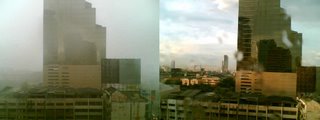
ควันบุหรี่บางๆ จางๆ กำลังลอยคว้างอยู่กลางอากาศ
แสงไฟจากที่มืดสลัว บัดนี้กลับพลันสว่าง
จากที่เคยเป็นดินแดนแห่งความฝันไร้ขอบเขต
วินาทีนี้ Noriaga's กลับกลายเป็นสถานที่ที่มีอยู่จริงบนโลกใบนี้--อีกครั้ง
เหมือนอย่างที่มันเคยเป็น
ทุกสิ่งทุกอย่างในโลกล้วนมีจังหวะของมัน
มีงานเลี้ยงที่ไหนในโลกบ้าง?--ที่ไม่มีวันเลิกลา
นักดนตรีที่อยู่บนเวทีกำลังเก็บเครื่องดนตรี--ตัวโน้ตตัวสุดท้าย
ได้ถูกกลืนหายไปในบรรยากาศที่อยู่โดยรอบ
สิ่งที่ยังคงเหลืออยู่ในตอนนี้ื
ก็คงมีเพียงแค่คลื่นเสียงเหล่านั้น
ที่ประทับร่องรอยของมันในความทรงจำ
โลกในตอนนี้
จากที่เคยคึกครืนคึกคักไปด้วยแสงไฟ
-วินาทีนี้-
กลับกลายเป็น เงียบ ปราศจากแสงสี
ผู้คนทางด้านนอก จากที่เคยพลุกพล่าน-พรุ้งพรั่ง โกลาหล
-วินาทีนี้-
กลับกลายเป็น
บางตา
ภายในร้าน พนักงานกำลังเดินเก็บขวดเบียร์ที่เรี่ยราดอยู่ตามโต๊ะ
บ้างก็เริ่มปัดกวาดทำความสะอาด
ร่องรอยของความสุขและเศร้าของมนุษย์
ที่หล่นกลื่นกลาด
แล้วบรรยากาศโดยรอบก็เริ่มเปลี่ยนไป
เมื่อความเงียบได้ถูกแทนที่ด้วยเสียง
เสียงเหงาๆ ที่มนุษย์ทุกคนบนโลกล้วนรู้จัก
เสียงลึกลับที่มนุษย์เรียกมันว่า "ดนตรี"
"เวลาผ่านฉันไปอย่างรวดเร็ว
มันพาฉันร่องรอยออกไปจากรถของฉัน
และกำลังห่างไกลออกไปจากความเชื่องช้าเนิบนาบ, มันเป็นความรู้สึกพิเศษ
พระเจ้าเท่านั้นที่รู้ว่า, มันทำให้ฉันรู้สึกถึงการมีชีวิต"
ทอมกำลังนั่งทอดอารมณ์อยู่ที่ข้างๆ บาร์ ส่งยิ้มให้ดีเจที่เปิดเพลงนี้ที่อยู่หน้าร้าน
สายตาทอดออกไปข้างนอกผนังกระจก
ไกลออกไป
ไกลออกไป
.
.
.
ไกลออกไปจากโลกที่อยู่ทางด้านนอก
-วินาทีนี้-
เขาอาจจะไม่ได้อยู่ในสถานที่แห่งนี้
อาจจะอยู่ที่ไหนสักแห่ง--ที่ไหนสักแห่ง
ที่ไม่มีแม้แต่ตำแหน่ง แห่งที่
อสถานที่ ที่เราเรียกมันว่า
'ความทรงจำ'
"ขณะนี้ พระอาทิตย์กำลังอยู่ที่ตรงขอบฟ้า
และฉันกำลังนั่งอยู่กับผู้หญิงที่แสนดี
ถนน รถยนต์ และรถบรรทุก
แสงดาวกำลังจางและมันนำฉันไปสู่พระราชวังที่แสนงาม
ฉันอยากจะเหนี่ยวรั้งวินาทีเหล่านี้ ให้เนิ่นนาน
โอ้พระเจ้า ช่วยบอกฉันที่ว่า
ทำยังไงที่จะให้ความรู้สึกเหล่านี้--นั้นไม่จาง"
ผมจำเพลงนี้ได้--Ol'55 มันเป็นเพลงของ ทอม (Tom Waits)
ทอมแต่งเพลงนี้ขึ้นจากความประทับใจในประสบการณ์ที่เกิดขึ้น
ในเช้าวันหนึ่ง
ขณะที่ขับรถออกจากงานเลี้ยงสังสรรค์งานหนึ่ง
เพื่อกลับบ้าน
เช้าที่เกือบเช้า--แต่ยังไม่เช้า
ช่วงเวลาที่ในความสว่างของยามเช้านั้น
มีความมืดผสมอยู่บางๆ
เขาประทับใจในบรรยากาศนั้น
บรรยากาศที่ยากจะบรรยาย
"และตอนนี้เป็นเวลาหกโมงเช้า
ไม่มีสิ่งใดให้กังวล ตอนนี้ฉันกำลังอยู่บนทางที่แสนคุ้นเคย
รถบรรทุกกำลังวิ่งผ่านฉันไป และแสงไฟเหล่านั้นกำลังส่องมาที่ฉัน
ฉันอยู่บนหนทางของที่ทอดยาวมาไกล ไกลจากสถานที่ของคุณ"
And now the sun’s comin’ up, I’m ridin’ with Lady Luck
Freeway cars and trucks
Stars beginnin’ to fade, and I lead the parade
Just a-wishin’ I’d stayed a little longer
Oh Lord, let me tell you the feeling gettin’ stronger
And my time went so quickly
I went lickety-splitly out to my ol’ fifty-five
As I pulled away slowly, feelin’ so holy
God knows I was feelin’ alive
ไม่เพียงแค่ทอมเท่านั้น
ที่มีประสบการณ์กับบรรยากาศที่ยากจะบรรยายแบบนี้
อ๊อคเตวิโอ ปาซ (Octavio Paz) กวีชาวเม๊กซิกัน
ก็เคยเขียนกวีบทหนึ่งเอาไว้ว่า:-
Between what I see and what I say
Between what I say and what I keep silent
Between what I keep silent and what I dream
Between what I dream and what I forget:
ตอนนี้ใกล้เช้าเต็มที
ทอมกำลังเดินออกไปจากร้าน
"เช้าแล้วซินะ"
ผมว่าเขาคงกำลังเดินทางกลับบ้านแล้ว
แสงจางๆ กำลังปรากฎมุมหนึ่งของขอบฟ้า
ท่ามกลางตึกสูง บนถนนสีลม
"เวลาผ่านฉันไปอย่างรวดเร็ว
มันพาฉันหลุดออกไปจากรถของฉัน
และกำลังห่างไกลออกไปจากความหนืดเนือย, มันเป็นความรู้สึกพิเศษ
พระเจ้าเท่านั้นที่รู้,
มันทำให้ฉันรู้สึกได้ว่ากำลังมีชีวิต"
ในเพลง Ol'55 ทอมไม่บอกว่าสิ่งที่อธิบายยากส่ิ่งนั้นคืออะไร
"สิ่งใดกันที่ทำให้รู้สึกได้ ว่ากำลังมีชีวิต"
กลอนของอ๊อคเตวิโอ ปาซ บทเมื่อกี้นี้ยังไม่จบ
ในท่อนสุดท้าย
ปาซเรียกสิ่งที่ยากจะอธิบาย
สิ่งนั้นว่า
"Poetry--กวี"
+:+:+:+:+:+:+:+:+:+:+:+:+:+:+:+:+:+:+:+:+:+:+:+:+:+:+:+:++:+:+:+:+:+:+

Tom Waits--Closing Time (1973)
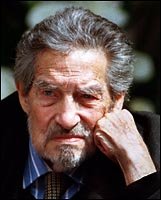
ข้อมูลเพิ่มเติมเกี่ยวกับ Octavio Paz
http://nobelprize.org/nobel_prizes/literature/laureates/1990/paz-bio.html
+:+:+:+:+:+:+:+:+:+:+:+:+:+:+:+:+:+:+:+:+:+:+:+:+:+:+:+:++:+:+:+:+:+:+
Book bought:
-
Books read:
-โกธ: คดีตัดข้อมือ(GOTH: Wrist Cut Jiken)--Otsuichi แปลโดย นะนะโกะ (ยืม peach มาอ่าน)
-คุโรมาตี้ โรงเรียนคนบวม เล่ม 13--โนนากะ เอย์จิ

ควันบุหรี่บางๆ จางๆ กำลังลอยคว้างอยู่กลางอากาศ
แสงไฟจากที่มืดสลัว บัดนี้กลับพลันสว่าง
จากที่เคยเป็นดินแดนแห่งความฝันไร้ขอบเขต
วินาทีนี้ Noriaga's กลับกลายเป็นสถานที่ที่มีอยู่จริงบนโลกใบนี้--อีกครั้ง
เหมือนอย่างที่มันเคยเป็น
ทุกสิ่งทุกอย่างในโลกล้วนมีจังหวะของมัน
มีงานเลี้ยงที่ไหนในโลกบ้าง?--ที่ไม่มีวันเลิกลา
นักดนตรีที่อยู่บนเวทีกำลังเก็บเครื่องดนตรี--ตัวโน้ตตัวสุดท้าย
ได้ถูกกลืนหายไปในบรรยากาศที่อยู่โดยรอบ
สิ่งที่ยังคงเหลืออยู่ในตอนนี้ื
ก็คงมีเพียงแค่คลื่นเสียงเหล่านั้น
ที่ประทับร่องรอยของมันในความทรงจำ
โลกในตอนนี้
จากที่เคยคึกครืนคึกคักไปด้วยแสงไฟ
-วินาทีนี้-
กลับกลายเป็น เงียบ ปราศจากแสงสี
ผู้คนทางด้านนอก จากที่เคยพลุกพล่าน-พรุ้งพรั่ง โกลาหล
-วินาทีนี้-
กลับกลายเป็น
บางตา
ภายในร้าน พนักงานกำลังเดินเก็บขวดเบียร์ที่เรี่ยราดอยู่ตามโต๊ะ
บ้างก็เริ่มปัดกวาดทำความสะอาด
ร่องรอยของความสุขและเศร้าของมนุษย์
ที่หล่นกลื่นกลาด
แล้วบรรยากาศโดยรอบก็เริ่มเปลี่ยนไป
เมื่อความเงียบได้ถูกแทนที่ด้วยเสียง
เสียงเหงาๆ ที่มนุษย์ทุกคนบนโลกล้วนรู้จัก
เสียงลึกลับที่มนุษย์เรียกมันว่า "ดนตรี"
"เวลาผ่านฉันไปอย่างรวดเร็ว
มันพาฉันร่องรอยออกไปจากรถของฉัน
และกำลังห่างไกลออกไปจากความเชื่องช้าเนิบนาบ, มันเป็นความรู้สึกพิเศษ
พระเจ้าเท่านั้นที่รู้ว่า, มันทำให้ฉันรู้สึกถึงการมีชีวิต"
ทอมกำลังนั่งทอดอารมณ์อยู่ที่ข้างๆ บาร์ ส่งยิ้มให้ดีเจที่เปิดเพลงนี้ที่อยู่หน้าร้าน
สายตาทอดออกไปข้างนอกผนังกระจก
ไกลออกไป
ไกลออกไป
.
.
.
ไกลออกไปจากโลกที่อยู่ทางด้านนอก
-วินาทีนี้-
เขาอาจจะไม่ได้อยู่ในสถานที่แห่งนี้
อาจจะอยู่ที่ไหนสักแห่ง--ที่ไหนสักแห่ง
ที่ไม่มีแม้แต่ตำแหน่ง แห่งที่
อสถานที่ ที่เราเรียกมันว่า
'ความทรงจำ'
"ขณะนี้ พระอาทิตย์กำลังอยู่ที่ตรงขอบฟ้า
และฉันกำลังนั่งอยู่กับผู้หญิงที่แสนดี
ถนน รถยนต์ และรถบรรทุก
แสงดาวกำลังจางและมันนำฉันไปสู่พระราชวังที่แสนงาม
ฉันอยากจะเหนี่ยวรั้งวินาทีเหล่านี้ ให้เนิ่นนาน
โอ้พระเจ้า ช่วยบอกฉันที่ว่า
ทำยังไงที่จะให้ความรู้สึกเหล่านี้--นั้นไม่จาง"
ผมจำเพลงนี้ได้--Ol'55 มันเป็นเพลงของ ทอม (Tom Waits)
ทอมแต่งเพลงนี้ขึ้นจากความประทับใจในประสบการณ์ที่เกิดขึ้น
ในเช้าวันหนึ่ง
ขณะที่ขับรถออกจากงานเลี้ยงสังสรรค์งานหนึ่ง
เพื่อกลับบ้าน
เช้าที่เกือบเช้า--แต่ยังไม่เช้า
ช่วงเวลาที่ในความสว่างของยามเช้านั้น
มีความมืดผสมอยู่บางๆ
เขาประทับใจในบรรยากาศนั้น
บรรยากาศที่ยากจะบรรยาย
"และตอนนี้เป็นเวลาหกโมงเช้า
ไม่มีสิ่งใดให้กังวล ตอนนี้ฉันกำลังอยู่บนทางที่แสนคุ้นเคย
รถบรรทุกกำลังวิ่งผ่านฉันไป และแสงไฟเหล่านั้นกำลังส่องมาที่ฉัน
ฉันอยู่บนหนทางของที่ทอดยาวมาไกล ไกลจากสถานที่ของคุณ"
And now the sun’s comin’ up, I’m ridin’ with Lady Luck
Freeway cars and trucks
Stars beginnin’ to fade, and I lead the parade
Just a-wishin’ I’d stayed a little longer
Oh Lord, let me tell you the feeling gettin’ stronger
And my time went so quickly
I went lickety-splitly out to my ol’ fifty-five
As I pulled away slowly, feelin’ so holy
God knows I was feelin’ alive
ไม่เพียงแค่ทอมเท่านั้น
ที่มีประสบการณ์กับบรรยากาศที่ยากจะบรรยายแบบนี้
อ๊อคเตวิโอ ปาซ (Octavio Paz) กวีชาวเม๊กซิกัน
ก็เคยเขียนกวีบทหนึ่งเอาไว้ว่า:-
Between what I see and what I say
Between what I say and what I keep silent
Between what I keep silent and what I dream
Between what I dream and what I forget:
ตอนนี้ใกล้เช้าเต็มที
ทอมกำลังเดินออกไปจากร้าน
"เช้าแล้วซินะ"
ผมว่าเขาคงกำลังเดินทางกลับบ้านแล้ว
แสงจางๆ กำลังปรากฎมุมหนึ่งของขอบฟ้า
ท่ามกลางตึกสูง บนถนนสีลม
"เวลาผ่านฉันไปอย่างรวดเร็ว
มันพาฉันหลุดออกไปจากรถของฉัน
และกำลังห่างไกลออกไปจากความหนืดเนือย, มันเป็นความรู้สึกพิเศษ
พระเจ้าเท่านั้นที่รู้,
มันทำให้ฉันรู้สึกได้ว่ากำลังมีชีวิต"
ในเพลง Ol'55 ทอมไม่บอกว่าสิ่งที่อธิบายยากส่ิ่งนั้นคืออะไร
"สิ่งใดกันที่ทำให้รู้สึกได้ ว่ากำลังมีชีวิต"
กลอนของอ๊อคเตวิโอ ปาซ บทเมื่อกี้นี้ยังไม่จบ
ในท่อนสุดท้าย
ปาซเรียกสิ่งที่ยากจะอธิบาย
สิ่งนั้นว่า
"Poetry--กวี"
+:+:+:+:+:+:+:+:+:+:+:+:+:+:+:+:+:+:+:+:+:+:+:+:+:+:+:+:++:+:+:+:+:+:+

Tom Waits--Closing Time (1973)

ข้อมูลเพิ่มเติมเกี่ยวกับ Octavio Paz
http://nobelprize.org/nobel_prizes/literature/laureates/1990/paz-bio.html
+:+:+:+:+:+:+:+:+:+:+:+:+:+:+:+:+:+:+:+:+:+:+:+:+:+:+:+:++:+:+:+:+:+:+
Book bought:
-
Books read:
-โกธ: คดีตัดข้อมือ(GOTH: Wrist Cut Jiken)--Otsuichi แปลโดย นะนะโกะ (ยืม peach มาอ่าน)
-คุโรมาตี้ โรงเรียนคนบวม เล่ม 13--โนนากะ เอย์จิ
Sunday, September 17, 2006
Bob Dylan in My Loft
2006-09-17
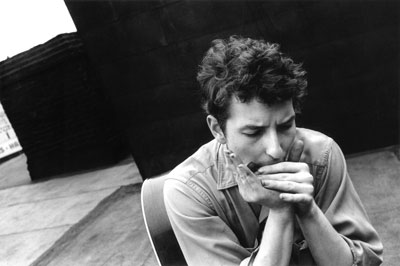
Bob Dylan In My Loft--April 1962
*นิตยสาร B&W เล่มใหม่ล่าสุด(September 2006)--ฉบับ Young Bob สัมภาษณ์ John Cohen ช่างภาพที่ถ่ายภาพนี้
New York City, early spring 1962: Two young men are hanging out on the rooftop of building on third Avenue, one holding a camera, the other a guitar. The man with the guitar is Bob Dylan, 22 years old and newly arrived on New York music scence. The photographer, John Cohen, isn't quite sure what to expect, but what ensues is a unique collaboration between artist and photographer.
online Gallery:
http://www.iceboxminnesota.com/Bob/cohen_gallery.html
+:+:+:+:+:+:+:+:+:+:+:+:+:+:+:+:+:+:+:+:+:+:+:+:+:+:+:+:++:+:+:+:+:+:+

Bauhaus 1919-1933
Magdalena Droste
ISBN 3-8228-5002-0
Best of Bauhaus: An in-depth study of the seminal movement in art and architecture
(TASCHEN's 25th anniversary - Special edition)
The Bauhaus Archiv Museum of Design in Berlin holds the most important collection on the Bauhaus today. Documents, workshop products from all areas of design, studies sketches in the classroom, and architectural plans and models are all part of its comprehensive inventory. The Bauhaus Archiv is dedicated to the study and presentation of the history of the Bauhaus, including the new Bauhaus in Chicago and the Hochschule für Gestaltung (Institute of Design) in Ulm. This book, drawn from the Archiv's extensive collection, traces this monumental movement in art and architecture via the work of its most important proponents, including Walter Gropius, Marcel Breuer, Vassily Kandinsky, and Paul Klee.
The author: Magdalena Droste studied art history and literature in Aachen and Marburg. She has worked at the Bauhaus Archiv in Berlin since 1980. She has contributed to numerous exhibitions and publications an Bauhaus artists and has also written a number of essays on the furniture and textile workshops at the Bauhaus and on arts and crafts as a woman’s profession.
+:+:+:+:+:+:+:+:+:+:+:+:+:+:+:+:+:+:+:+:+:+:+:+:+:+:+:+:++:+:+:+:+:+:+
Book bought:
-Bauhaus 1919-1933--Magdalena Droste (TASCHEN's 25th Anniversary special edition)
Books read:
-โกธ: คดีตัดข้อมือ(GOTH: Wrist Cut Jiken)--Otsuichi แปลโดย นะนะโกะ (ยืม peach มาอ่าน)
-Dialogue: Relationships in Graphic Design--Shaun Cole
-B&W Magazine (issue45)--September 2006

Bob Dylan In My Loft--April 1962
*นิตยสาร B&W เล่มใหม่ล่าสุด(September 2006)--ฉบับ Young Bob สัมภาษณ์ John Cohen ช่างภาพที่ถ่ายภาพนี้
New York City, early spring 1962: Two young men are hanging out on the rooftop of building on third Avenue, one holding a camera, the other a guitar. The man with the guitar is Bob Dylan, 22 years old and newly arrived on New York music scence. The photographer, John Cohen, isn't quite sure what to expect, but what ensues is a unique collaboration between artist and photographer.
online Gallery:
http://www.iceboxminnesota.com/Bob/cohen_gallery.html
+:+:+:+:+:+:+:+:+:+:+:+:+:+:+:+:+:+:+:+:+:+:+:+:+:+:+:+:++:+:+:+:+:+:+

Bauhaus 1919-1933
Magdalena Droste
ISBN 3-8228-5002-0
Best of Bauhaus: An in-depth study of the seminal movement in art and architecture
(TASCHEN's 25th anniversary - Special edition)
The Bauhaus Archiv Museum of Design in Berlin holds the most important collection on the Bauhaus today. Documents, workshop products from all areas of design, studies sketches in the classroom, and architectural plans and models are all part of its comprehensive inventory. The Bauhaus Archiv is dedicated to the study and presentation of the history of the Bauhaus, including the new Bauhaus in Chicago and the Hochschule für Gestaltung (Institute of Design) in Ulm. This book, drawn from the Archiv's extensive collection, traces this monumental movement in art and architecture via the work of its most important proponents, including Walter Gropius, Marcel Breuer, Vassily Kandinsky, and Paul Klee.
The author: Magdalena Droste studied art history and literature in Aachen and Marburg. She has worked at the Bauhaus Archiv in Berlin since 1980. She has contributed to numerous exhibitions and publications an Bauhaus artists and has also written a number of essays on the furniture and textile workshops at the Bauhaus and on arts and crafts as a woman’s profession.
+:+:+:+:+:+:+:+:+:+:+:+:+:+:+:+:+:+:+:+:+:+:+:+:+:+:+:+:++:+:+:+:+:+:+
Book bought:
-Bauhaus 1919-1933--Magdalena Droste (TASCHEN's 25th Anniversary special edition)
Books read:
-โกธ: คดีตัดข้อมือ(GOTH: Wrist Cut Jiken)--Otsuichi แปลโดย นะนะโกะ (ยืม peach มาอ่าน)
-Dialogue: Relationships in Graphic Design--Shaun Cole
-B&W Magazine (issue45)--September 2006
Saturday, September 16, 2006
ความหมายของสิ่งนั้น
2006-09-16
ในหนังเรื่อง Almost Famous ของผู้กำกับ คาเมรอน โครว์ มีฉากหนึ่ง ที่พี่สาวของพระเอกหนีออกจากบ้าน เธอได้ทิ้งแผ่นเสียงแผ่นหนึ่งไว้ให้น้องชาย มันเป็นแผ่นเสียงของวง Simon & Garfunkel อัลบั้ม Bookends พร้อมกับทิ้งโน้ตไว้ว่า "เธอต้องเติบโต" แล้วเสียงเพลงประกอบเพลงนั้น--America ก็ดังขึ้นมา:-
"Let us be lovers, we'll marry our fortunes together
I've got some real estate here in my bag"
So we bought a pack of cigarettes and Mrs. Wagner pies
And walked off to look for America
ไม่รู้ว่ามีส่ิงใดอยู่ในความคิดของ ฟริตจ๊อฟ คาปร้า ในช่วงเวลานั้น(เช่นกัน) ที่ทำให้นักฟิสิกส์ แห่งมหาวิทยาลัยเบิร์กเลย์ ทิ้งงานในห้องวิจัย สะพายเป้ ระเหเร่ร่อนเดินทาง คงมีคำถามอะไรบางอย่างกำลังเดินป้วนเปี้ยนอยู่ในหัวของเขา
มันอาจจะเป็นคำถามที่ทำให้เขาตัดสินใจ walked off to look for ...(อะไรสักอย่าง)
คงมีอะไรซักอย่างอยู่ที่ท้ายรถกระบะที่เขานั่ง อะไรซักอย่าง ในวงสนทนากลางสนามหญ้าของคนหนุ่มสาวที่อยู่นอกรั้วมหาวิทยาลัย อะไรซักอย่างหนึ่งในแสงแดดยามบ่ายในขณะที่เขากำลังนอนเอกเขนกดูก้อนเมฆบนฟ้า อะไรซักอย่างบนคลื่นในทะเล อะไรซักอย่างในวงปุ๊นกัญชาของพวกฮิปปี้ อะไรซักอย่างในหนังสือ on the Road ของ Jack Kerouac ที่เขาอ่านในถุงนอนกลางป่าเขา ภายใต้แสงจันทร์ดวงนั้น
เขาใช้เวลากว่าสิบกว่าปีในการค้นหาคำตอบ ด้วยการเดินทางออกไปสนทนาพูดคุยกับคนอื่นๆ ในหลากหลายอาชีพ หลากหลายความเชื่อ หลากหลายเชื้อชาติ และหลากหลายศาสนา
เขาคุยกับมนุษย์ได้หมด--ไม่ว่ามนุษย์คนนั้นจะคิดเหมือนหรือคิดต่างจากเขาก็ตาม(บางเวลาที่เขาเบื่อที่จะคุยกับมนุษย์ด้วยกัน เขาก็คุยกับต้นไม้ แสงแดด สายลม หรือไม่ก็คลื่นในทะเล)
หนังสืออย่าง The Tao of Physics และ The Turning Point ก็คือดอกผลของคำถามเหล่านั้น
(โชคยังคงเข้าข้างคนอ่านอย่างเราๆ ที่ คาปร้า เป็นแค่นักฟิสิกส์ ที่ปราดเปรื่อง และเปิดกว้าง ไม่ได้เป็นนักธุรกิจหรือนักการตลาดที่ฉลาดล้ำ เพราะไม่ว่าจะมองยังไงการใช้เวลาสิบกว่าปีเพื่อเขียนหนังสือสองเล่ม คิดคำนวณกันจนเครื่องคิดเลขพัง ก็ไม่เห็นจะคุ้มค่าต่อการลงทุนตรงไหน :P)
สำหรับคนที่เคยอ่านหนังสือที่เราพูดถึงในย่อหน้าที่แล้วทั้งสองเล่มของคาปร้าแล้ว ถ้ายังไม่เคยอ่านเล่มที่มีชื่อว่า Uncommon Wisdom:Conversations with Remarkable people บอกได้คำเดียวว่า "ห้ามพลาด!"
เพราะมันเป็นหนังสือที่เป็นเสมือนบันทึกเบื้องหลังการทำงานเขียนหนังสือทั้งสองเล่มข้างต้น ซึ่งสามารถสะท้อนมุมมองที่น่ารักของผู้ชายคนนี้ รวมถึงทฤษฎีในการปฏิสัมพันธ์กับผู้คนที่คาปร้าคิดขึ้นมา ซึ่งดูยังไงมันก็ไม่เป็นวิทยาศาสตร์เอาเสียเลย แต่มันก็ทำให้คุณอมยิ้มได้
ซึ่งทำได้แค่นี้ก็อาจจะพอเพียงแล้วในการเกิดเป็นมนุษย์สักหนหนึ่ง
(ยังไม่จบ ^_^)
+:+:+:+:+:+:+:+:+:+:+:+:+:+:+:+:+:+:+:+:+:+:+:+:+:+:+:+:++:+:+:+:+:+:+

Simon & Garfunkel--Bookends(1968)
+:+:+:+:+:+:+:+:+:+:+:+:+:+:+:+:+:+:+:+:+:+:+:+:+:+:+:+:++:+:+:+:+:+:+

SuperDutch New Architecture in the Netherlands
Bart Lootsma
ISBN: 1-56898-239-9
Superdutch showcases the works of the most exciting Dutch designers on the current architecture scene. The built environment of the Netherlands is comparatively very young; as stated in the introduction, over 75 percent of the countrys buildings came after the Second World War. The government and planning authorities have been known to adopt sensible planning philosophies, while individual pioneers such as Rem Koolhaas helped pave the way for the modern era of design that the country enjoys today.Following the written introduction to modern architecture in the Netherlands, the book displays selected works of twelve contemporary local architects, including housing, public spaces, art installations and concept designs.
+:+:+:+:+:+:+:+:+:+:+:+:+:+:+:+:+:+:+:+:+:+:+:+:+:+:+:+:++:+:+:+:+:+:+
Book bought:
-
Books read:
-โกธ: คดีตัดข้อมือ(GOTH: Wrist Cut Jiken)--Otsuichi แปลโดย นะนะโกะ (ยืม peach มาอ่าน)
-Superdutch: New Architecture in The Netherlands--Bart Lootsma
ในหนังเรื่อง Almost Famous ของผู้กำกับ คาเมรอน โครว์ มีฉากหนึ่ง ที่พี่สาวของพระเอกหนีออกจากบ้าน เธอได้ทิ้งแผ่นเสียงแผ่นหนึ่งไว้ให้น้องชาย มันเป็นแผ่นเสียงของวง Simon & Garfunkel อัลบั้ม Bookends พร้อมกับทิ้งโน้ตไว้ว่า "เธอต้องเติบโต" แล้วเสียงเพลงประกอบเพลงนั้น--America ก็ดังขึ้นมา:-
"Let us be lovers, we'll marry our fortunes together
I've got some real estate here in my bag"
So we bought a pack of cigarettes and Mrs. Wagner pies
And walked off to look for America
ไม่รู้ว่ามีส่ิงใดอยู่ในความคิดของ ฟริตจ๊อฟ คาปร้า ในช่วงเวลานั้น(เช่นกัน) ที่ทำให้นักฟิสิกส์ แห่งมหาวิทยาลัยเบิร์กเลย์ ทิ้งงานในห้องวิจัย สะพายเป้ ระเหเร่ร่อนเดินทาง คงมีคำถามอะไรบางอย่างกำลังเดินป้วนเปี้ยนอยู่ในหัวของเขา
มันอาจจะเป็นคำถามที่ทำให้เขาตัดสินใจ walked off to look for ...(อะไรสักอย่าง)
คงมีอะไรซักอย่างอยู่ที่ท้ายรถกระบะที่เขานั่ง อะไรซักอย่าง ในวงสนทนากลางสนามหญ้าของคนหนุ่มสาวที่อยู่นอกรั้วมหาวิทยาลัย อะไรซักอย่างหนึ่งในแสงแดดยามบ่ายในขณะที่เขากำลังนอนเอกเขนกดูก้อนเมฆบนฟ้า อะไรซักอย่างบนคลื่นในทะเล อะไรซักอย่างในวงปุ๊นกัญชาของพวกฮิปปี้ อะไรซักอย่างในหนังสือ on the Road ของ Jack Kerouac ที่เขาอ่านในถุงนอนกลางป่าเขา ภายใต้แสงจันทร์ดวงนั้น
เขาใช้เวลากว่าสิบกว่าปีในการค้นหาคำตอบ ด้วยการเดินทางออกไปสนทนาพูดคุยกับคนอื่นๆ ในหลากหลายอาชีพ หลากหลายความเชื่อ หลากหลายเชื้อชาติ และหลากหลายศาสนา
เขาคุยกับมนุษย์ได้หมด--ไม่ว่ามนุษย์คนนั้นจะคิดเหมือนหรือคิดต่างจากเขาก็ตาม(บางเวลาที่เขาเบื่อที่จะคุยกับมนุษย์ด้วยกัน เขาก็คุยกับต้นไม้ แสงแดด สายลม หรือไม่ก็คลื่นในทะเล)
หนังสืออย่าง The Tao of Physics และ The Turning Point ก็คือดอกผลของคำถามเหล่านั้น
(โชคยังคงเข้าข้างคนอ่านอย่างเราๆ ที่ คาปร้า เป็นแค่นักฟิสิกส์ ที่ปราดเปรื่อง และเปิดกว้าง ไม่ได้เป็นนักธุรกิจหรือนักการตลาดที่ฉลาดล้ำ เพราะไม่ว่าจะมองยังไงการใช้เวลาสิบกว่าปีเพื่อเขียนหนังสือสองเล่ม คิดคำนวณกันจนเครื่องคิดเลขพัง ก็ไม่เห็นจะคุ้มค่าต่อการลงทุนตรงไหน :P)
สำหรับคนที่เคยอ่านหนังสือที่เราพูดถึงในย่อหน้าที่แล้วทั้งสองเล่มของคาปร้าแล้ว ถ้ายังไม่เคยอ่านเล่มที่มีชื่อว่า Uncommon Wisdom:Conversations with Remarkable people บอกได้คำเดียวว่า "ห้ามพลาด!"
เพราะมันเป็นหนังสือที่เป็นเสมือนบันทึกเบื้องหลังการทำงานเขียนหนังสือทั้งสองเล่มข้างต้น ซึ่งสามารถสะท้อนมุมมองที่น่ารักของผู้ชายคนนี้ รวมถึงทฤษฎีในการปฏิสัมพันธ์กับผู้คนที่คาปร้าคิดขึ้นมา ซึ่งดูยังไงมันก็ไม่เป็นวิทยาศาสตร์เอาเสียเลย แต่มันก็ทำให้คุณอมยิ้มได้
ซึ่งทำได้แค่นี้ก็อาจจะพอเพียงแล้วในการเกิดเป็นมนุษย์สักหนหนึ่ง
(ยังไม่จบ ^_^)
+:+:+:+:+:+:+:+:+:+:+:+:+:+:+:+:+:+:+:+:+:+:+:+:+:+:+:+:++:+:+:+:+:+:+

Simon & Garfunkel--Bookends(1968)
+:+:+:+:+:+:+:+:+:+:+:+:+:+:+:+:+:+:+:+:+:+:+:+:+:+:+:+:++:+:+:+:+:+:+

SuperDutch New Architecture in the Netherlands
Bart Lootsma
ISBN: 1-56898-239-9
Superdutch showcases the works of the most exciting Dutch designers on the current architecture scene. The built environment of the Netherlands is comparatively very young; as stated in the introduction, over 75 percent of the countrys buildings came after the Second World War. The government and planning authorities have been known to adopt sensible planning philosophies, while individual pioneers such as Rem Koolhaas helped pave the way for the modern era of design that the country enjoys today.Following the written introduction to modern architecture in the Netherlands, the book displays selected works of twelve contemporary local architects, including housing, public spaces, art installations and concept designs.
+:+:+:+:+:+:+:+:+:+:+:+:+:+:+:+:+:+:+:+:+:+:+:+:+:+:+:+:++:+:+:+:+:+:+
Book bought:
-
Books read:
-โกธ: คดีตัดข้อมือ(GOTH: Wrist Cut Jiken)--Otsuichi แปลโดย นะนะโกะ (ยืม peach มาอ่าน)
-Superdutch: New Architecture in The Netherlands--Bart Lootsma
Dining Time
2006-09-15
วันนี้พอดีช่วงบ่ายพอดีต้องไปทำธุระที่ Japan Foundation ที่ตึกเสริมมิตร(ไปต่ออายุสมาชิกห้องสมุด) ก็เลยได้มีโอกาสได้เข้าไปดูนิทรรศการศิลปะของ Shigeaiki Iwai ที่มีชื่อว่า "Dining Time" ซึ่งกำลังจัดแสดงอยู่ที่ ห้องแสดงนิทรรศการของมูลนิธิ
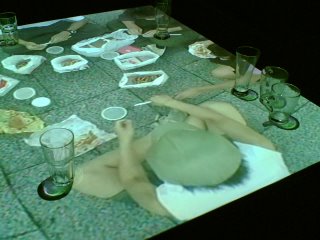
From Shigeaki Iwai 's website
バンコクの国際交流基金内アートスペースにおいて、ビデオ・インスタレーションによる個展「Dining Time」が9月30日まで開催されています。この作品は「食卓の時間」をモチーフに、私たちの生活の中で変化しつつある人間関係に言及したものです。また、魅力的な食文化を持つタイという国と、同世代アートの中で早くから「食」に関わる表現にとりくんできた、タイ・アーティスト達へのささやかなオマージュでもあります。現地の有力紙The Nationにおいては「Brain food」という、まさに正鵠を射るタイトルで紹介されました。
My latest video installation titled Dining Time can be seen at the Japan Foundation Art Space Bangkok from September 13 to 30. The work puts a question to our contemporary life as to the meaning of dining at a table amid the uniformity of foods, collapsing of families and local communities arising from so called globalization. Also I created this work to pay homage to many artists who can sublimate various social contexts and structures of taking meals into artistic expression, which indicate a close relationship between cuisine and culture in Thailand.
Proverbs on the floor/สำนวนบนพื้นนิทรรศการ
"ท้องว่างเป็นเรื่องน่าไม่อาย แต่ท้องอิ่มน่าไม่อายยิ่งกว่า"
"เนื้อต้องเข้าปากถึงจะรู้รส คำพูดต้องออกจากปากถึงจะได้รส"
"อาหารขึ้นโต๊ะปุ๊บ หยุดทะเลาะกันปั๊บ"
"สิ่งสำคัญคือคุณกินอาหารกับใครต่างหาก ไม่ใช่คุณกำลังกินอะไร"
"คนที่ไม่เคยไปไหน กับข้าวของแม่ย่อมอร่อยที่สุด"
"ถึงเศร้า ก็ยังกิน แต่พอสุข กลับลืมกิน"
"เนื้อหมาป่า ก็ต้องกินกับซอสเนื้อหมา"
+:+:+:+:+:+:+:+:+:+:+:+:+:+:+:+:+:+:+:+:+:+:+:+:+:+:+:+:++:+:+:+:+:+:+

Japanese Portraits: Pictures Of Different People
Donald Richie
ISBN: 0-8048-3772-4
The private collections of longtime Japan resident Donald Richie capture the personalities of certain Japanese people--some famous, some unknown--with insight and humor. Richie, who considers himself a foreigner despite living in Japan for over 53 years, is a keen observer of human nature. In Japanese Portraits, he provides an elegant and perceptive vision of Japan through precise, intimate portraits of ordinary and extraordinary Japanese people. Portraits include such notable Japanese as acclaimed filmmakers Akira Kurowasa and Yasujiro Ozu, famed novelist Yukio Mishima, and celebrated actor Toshiro Mifune.
Donald Richie was born in Lima, OH in 1924 and has lived in Japan since 1947. The author of thirty books and dozens of essays, Richie is especially well known for his travel memoir The Inland Sea which has been adapted into a popular PBS documentary. His best-known collection is The Donald Richie Reader, which contains 50 years of his writings on Japan.
+:+:+:+:+:+:+:+:+:+:+:+:+:+:+:+:+:+:+:+:+:+:+:+:+:+:+:+:++:+:+:+:+:+:+
Book bought:
-Japanese Portraits--Donald Richie
Books read:
-Art4d Magazine (Number 129)--August 2006
-นิตยสารสารคดี ฉบับที่ 258--สิงหาคม 2549
-Back to Front: Tourisms of War--Edited by Diller+Scofidio
วันนี้พอดีช่วงบ่ายพอดีต้องไปทำธุระที่ Japan Foundation ที่ตึกเสริมมิตร(ไปต่ออายุสมาชิกห้องสมุด) ก็เลยได้มีโอกาสได้เข้าไปดูนิทรรศการศิลปะของ Shigeaiki Iwai ที่มีชื่อว่า "Dining Time" ซึ่งกำลังจัดแสดงอยู่ที่ ห้องแสดงนิทรรศการของมูลนิธิ

From Shigeaki Iwai 's website
バンコクの国際交流基金内アートスペースにおいて、ビデオ・インスタレーションによる個展「Dining Time」が9月30日まで開催されています。この作品は「食卓の時間」をモチーフに、私たちの生活の中で変化しつつある人間関係に言及したものです。また、魅力的な食文化を持つタイという国と、同世代アートの中で早くから「食」に関わる表現にとりくんできた、タイ・アーティスト達へのささやかなオマージュでもあります。現地の有力紙The Nationにおいては「Brain food」という、まさに正鵠を射るタイトルで紹介されました。
My latest video installation titled Dining Time can be seen at the Japan Foundation Art Space Bangkok from September 13 to 30. The work puts a question to our contemporary life as to the meaning of dining at a table amid the uniformity of foods, collapsing of families and local communities arising from so called globalization. Also I created this work to pay homage to many artists who can sublimate various social contexts and structures of taking meals into artistic expression, which indicate a close relationship between cuisine and culture in Thailand.
Proverbs on the floor/สำนวนบนพื้นนิทรรศการ
"ท้องว่างเป็นเรื่องน่าไม่อาย แต่ท้องอิ่มน่าไม่อายยิ่งกว่า"
"เนื้อต้องเข้าปากถึงจะรู้รส คำพูดต้องออกจากปากถึงจะได้รส"
"อาหารขึ้นโต๊ะปุ๊บ หยุดทะเลาะกันปั๊บ"
"สิ่งสำคัญคือคุณกินอาหารกับใครต่างหาก ไม่ใช่คุณกำลังกินอะไร"
"คนที่ไม่เคยไปไหน กับข้าวของแม่ย่อมอร่อยที่สุด"
"ถึงเศร้า ก็ยังกิน แต่พอสุข กลับลืมกิน"
"เนื้อหมาป่า ก็ต้องกินกับซอสเนื้อหมา"
+:+:+:+:+:+:+:+:+:+:+:+:+:+:+:+:+:+:+:+:+:+:+:+:+:+:+:+:++:+:+:+:+:+:+

Japanese Portraits: Pictures Of Different People
Donald Richie
ISBN: 0-8048-3772-4
The private collections of longtime Japan resident Donald Richie capture the personalities of certain Japanese people--some famous, some unknown--with insight and humor. Richie, who considers himself a foreigner despite living in Japan for over 53 years, is a keen observer of human nature. In Japanese Portraits, he provides an elegant and perceptive vision of Japan through precise, intimate portraits of ordinary and extraordinary Japanese people. Portraits include such notable Japanese as acclaimed filmmakers Akira Kurowasa and Yasujiro Ozu, famed novelist Yukio Mishima, and celebrated actor Toshiro Mifune.
Donald Richie was born in Lima, OH in 1924 and has lived in Japan since 1947. The author of thirty books and dozens of essays, Richie is especially well known for his travel memoir The Inland Sea which has been adapted into a popular PBS documentary. His best-known collection is The Donald Richie Reader, which contains 50 years of his writings on Japan.
+:+:+:+:+:+:+:+:+:+:+:+:+:+:+:+:+:+:+:+:+:+:+:+:+:+:+:+:++:+:+:+:+:+:+
Book bought:
-Japanese Portraits--Donald Richie
Books read:
-Art4d Magazine (Number 129)--August 2006
-นิตยสารสารคดี ฉบับที่ 258--สิงหาคม 2549
-Back to Front: Tourisms of War--Edited by Diller+Scofidio
Thursday, September 14, 2006
2006-09-14
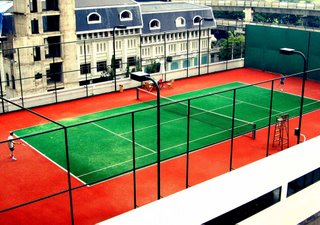
โครงสร้างรางรถไฟ้า/ ห้างสรรพสินค้าสถาปัตยกรรมยุโรปแบบปลอมๆ/ โครงสร้างอาคารเก่าทิ้งร้าง/ สนามเทนนิส/ leisure life/ ศูนย์ออกกำลังกาย/ ที่จอดรถ/ ห้องทำงานพนักงานของโรงแรม/ ห้องเครื่องขนาดใหญ่
+:+:+:+:+:+:+:+:+:+:+:+:+:+:+:+:+:+:+:+:+:+:+:+:+:+:+:+:++:+:+:+:+:+:+
Books bought:
1. คุโรมาตี้ โรงเรียนคนบวม เล่ม 13--โนนาโกะ เอย์จิ
Books read:
1. Art4d Magazine (number 129)--August 2006
2. Colors magazine 68
Wednesday, September 13, 2006
Winner/Loser
2006-09-13
วงสนทนารอบโต๊ะอาหาร ณ ร้านห่านพะโล้ชื่อดังแถวสามย่านในเย็นวันหนึ่ง เมื่อหลายเดือนที่แล้ว อาจารย์ที่เราเคารพนับถือ(และสนิทสนมที่สุด) ก็พูดขึ้นมาลอยๆ ว่า "โลกใบนี้มันไม่ใช่โลกที่ผมจะอยู่ได้มากขึ้นทุกๆ วันเลยว่ะ เห็นด้วยไม๊จี้" เราพยักหน้าตอบ เพราะพอจะเดาความคิดของอาจารย์เราออก
ว่ากำลังพูดถึงเรื่องอะไร
....
เมื่อเทศกาลบอลโลกที่ผ่านมา(ประมาณ 2เดือนที่แล้ว) ทั้งที่ปรกติเป็นคนไม่ชอบดูฟุตบอล (ตอนเด็กๆเราชอบนะ สาเหตุก็มาจากพวกการ์ตูน กัปตันซึบาสะเอย อิตโตนักเตะเลือดกังฟูเอย แต่เดี๋ยวนี้โตแล้ว--คิดว่าเลิกชอบแล้ว) แต่เพราะสถานการณ์บังคับ ต้องไปอยู่ในท่ามกลางกลุ่มของเพื่อนฝูงที่ชอบดูฟุตบอลในคืนที่กลุ่มเพื่อนนัดสังสรรค์กัน ทำให้ต้องตกบันไดพลอยดูไปด้วย (ว่าไงก็ว่าตามกัน:P)
จะว่าเราหัวโบราณก็ได้ ที่รู้สึกเศร้ากับบรรทัดฐานบางอย่าง (ที่เราคิดเอาเองว่าไม่ดี) ที่มีในเกมกีฬาชนิดนี้--ซึ่งเรารู้สึกว่าพฤติกรรมเหล่านี้นั้นห่างไกลจากคำว่า "น้ำใจของนักกีฬา" เช่น ไม่โดนศอกเลยสักนิด ก็ทำท่าลงไปชักดิ้นชักงอ เวลาเลี้ยงเข้าไปใกล้ในเขตโทษบางทีก็ทำท่าล้มลงให้เหมือนโดนเตะขา--แทนที่จะหาวิธียิงประตูให้ได้ แม้ว่าหนทางข้างหน้ามันจะริบหรี่ก็ตาม กลับจ้องแต่จะหาวิธีการล้มแหกตากรรมการให้แนบเนียนที่สุด พยายามช่วงชิงโอกาสในการทำประตูแบบสกปรก(อันนี้ก็เป็นความคิดของเราอีก) เพราะถ้าเป็นคำพูดของคนที่พากย์ฟุตบอลอย่าง เอกราช เก่งทุกทาง ก็จะบอกว่า "เป็นเทคนิคของมืออาชีพ ต้องทำทุกวิถีทางที่จะช่วงชิงความได้เปรียบ ทำยังไงก็ได้เพื่อให้ถึงเป้าหมายคือเป็นผู้ชนะ เพราะคนดูจะจดจำเราได้ในฐานะที่เป็นผู้ชนะ แต่ชนะยังไง ชนะแบบไหน เขาไม่สนใจหรอก"
จริงๆ หรอ?
มันสำคัญต่อการเป็นมนุษย์ขนาดนั้นเลยหรอ ในการที่เรานั้นจะแพ้หรือจะชนะ? :P
+:+:+:+:+:+:+:+:+:+:+:+:+:+:+:+:+:+:+:+:+:+:+:+:+:+:+:+:++:+:+:+:+:+:+

Breakfast of Champions
Kurt Vonnegut
ISBN: 0385334206
"We are healthy only to the extent that our ideas are humane." So reads the tombstone of downtrodden writer Kilgore Trout, but we have no doubt who's really talking: his alter ego Kurt Vonnegut. Health versus sickness, humanity versus inhumanity--both sets of ideas bounce through this challenging and funny book. As with the rest of Vonnegut's pure fantasy, it lacks the shimmering, fact-fueled rage that illuminates Slaughterhouse-Five. At the same time, that makes this book perhaps more enjoyable to read.
Breakfast of Champions is a slippery, lucid, bleakly humorous jaunt through (sick? inhumane?) America circa 1973, with Vonnegut acting as our Virgil-like companion. The book follows its main character, auto-dealing solid-citizen Dwayne Hoover, down into madness, a condition brought on by the work of the aforementioned Kilgore Trout. As Dwayne cracks, then crumbles, Breakfast of Champions coolly shows the effects his dementia has on the web of characters surrounding him. It's not much of a plot, but it's enough for Vonnegut to air unique opinions on America, sex, war, love, and all of his other pet topics--you know, the only ones that really count.
+:+:+:+:+:+:+:+:+:+:+:+:+:+:+:+:+:+:+:+:+:+:+:+:+:+:+:+:++:+:+:+:+:+:+
Books bought:
1. Breakfast of Champions--Kurt Vonnegut
2. Art4d Magazine (number 129)--August 2006
Books read:
1. Art4d Magazine (number 129)--August 2006
2. Chronicles Volume One--Bob Dylan
วงสนทนารอบโต๊ะอาหาร ณ ร้านห่านพะโล้ชื่อดังแถวสามย่านในเย็นวันหนึ่ง เมื่อหลายเดือนที่แล้ว อาจารย์ที่เราเคารพนับถือ(และสนิทสนมที่สุด) ก็พูดขึ้นมาลอยๆ ว่า "โลกใบนี้มันไม่ใช่โลกที่ผมจะอยู่ได้มากขึ้นทุกๆ วันเลยว่ะ เห็นด้วยไม๊จี้" เราพยักหน้าตอบ เพราะพอจะเดาความคิดของอาจารย์เราออก
ว่ากำลังพูดถึงเรื่องอะไร
....
เมื่อเทศกาลบอลโลกที่ผ่านมา(ประมาณ 2เดือนที่แล้ว) ทั้งที่ปรกติเป็นคนไม่ชอบดูฟุตบอล (ตอนเด็กๆเราชอบนะ สาเหตุก็มาจากพวกการ์ตูน กัปตันซึบาสะเอย อิตโตนักเตะเลือดกังฟูเอย แต่เดี๋ยวนี้โตแล้ว--คิดว่าเลิกชอบแล้ว) แต่เพราะสถานการณ์บังคับ ต้องไปอยู่ในท่ามกลางกลุ่มของเพื่อนฝูงที่ชอบดูฟุตบอลในคืนที่กลุ่มเพื่อนนัดสังสรรค์กัน ทำให้ต้องตกบันไดพลอยดูไปด้วย (ว่าไงก็ว่าตามกัน:P)
จะว่าเราหัวโบราณก็ได้ ที่รู้สึกเศร้ากับบรรทัดฐานบางอย่าง (ที่เราคิดเอาเองว่าไม่ดี) ที่มีในเกมกีฬาชนิดนี้--ซึ่งเรารู้สึกว่าพฤติกรรมเหล่านี้นั้นห่างไกลจากคำว่า "น้ำใจของนักกีฬา" เช่น ไม่โดนศอกเลยสักนิด ก็ทำท่าลงไปชักดิ้นชักงอ เวลาเลี้ยงเข้าไปใกล้ในเขตโทษบางทีก็ทำท่าล้มลงให้เหมือนโดนเตะขา--แทนที่จะหาวิธียิงประตูให้ได้ แม้ว่าหนทางข้างหน้ามันจะริบหรี่ก็ตาม กลับจ้องแต่จะหาวิธีการล้มแหกตากรรมการให้แนบเนียนที่สุด พยายามช่วงชิงโอกาสในการทำประตูแบบสกปรก(อันนี้ก็เป็นความคิดของเราอีก) เพราะถ้าเป็นคำพูดของคนที่พากย์ฟุตบอลอย่าง เอกราช เก่งทุกทาง ก็จะบอกว่า "เป็นเทคนิคของมืออาชีพ ต้องทำทุกวิถีทางที่จะช่วงชิงความได้เปรียบ ทำยังไงก็ได้เพื่อให้ถึงเป้าหมายคือเป็นผู้ชนะ เพราะคนดูจะจดจำเราได้ในฐานะที่เป็นผู้ชนะ แต่ชนะยังไง ชนะแบบไหน เขาไม่สนใจหรอก"
จริงๆ หรอ?
มันสำคัญต่อการเป็นมนุษย์ขนาดนั้นเลยหรอ ในการที่เรานั้นจะแพ้หรือจะชนะ? :P
+:+:+:+:+:+:+:+:+:+:+:+:+:+:+:+:+:+:+:+:+:+:+:+:+:+:+:+:++:+:+:+:+:+:+

Breakfast of Champions
Kurt Vonnegut
ISBN: 0385334206
"We are healthy only to the extent that our ideas are humane." So reads the tombstone of downtrodden writer Kilgore Trout, but we have no doubt who's really talking: his alter ego Kurt Vonnegut. Health versus sickness, humanity versus inhumanity--both sets of ideas bounce through this challenging and funny book. As with the rest of Vonnegut's pure fantasy, it lacks the shimmering, fact-fueled rage that illuminates Slaughterhouse-Five. At the same time, that makes this book perhaps more enjoyable to read.
Breakfast of Champions is a slippery, lucid, bleakly humorous jaunt through (sick? inhumane?) America circa 1973, with Vonnegut acting as our Virgil-like companion. The book follows its main character, auto-dealing solid-citizen Dwayne Hoover, down into madness, a condition brought on by the work of the aforementioned Kilgore Trout. As Dwayne cracks, then crumbles, Breakfast of Champions coolly shows the effects his dementia has on the web of characters surrounding him. It's not much of a plot, but it's enough for Vonnegut to air unique opinions on America, sex, war, love, and all of his other pet topics--you know, the only ones that really count.
+:+:+:+:+:+:+:+:+:+:+:+:+:+:+:+:+:+:+:+:+:+:+:+:+:+:+:+:++:+:+:+:+:+:+
Books bought:
1. Breakfast of Champions--Kurt Vonnegut
2. Art4d Magazine (number 129)--August 2006
Books read:
1. Art4d Magazine (number 129)--August 2006
2. Chronicles Volume One--Bob Dylan
Subscribe to:
Posts (Atom)

